Planning for Growth
VerifiedAdded on 2023/01/13
|19
|6096
|30
AI Summary
Contribute Materials
Your contribution can guide someone’s learning journey. Share your
documents today.
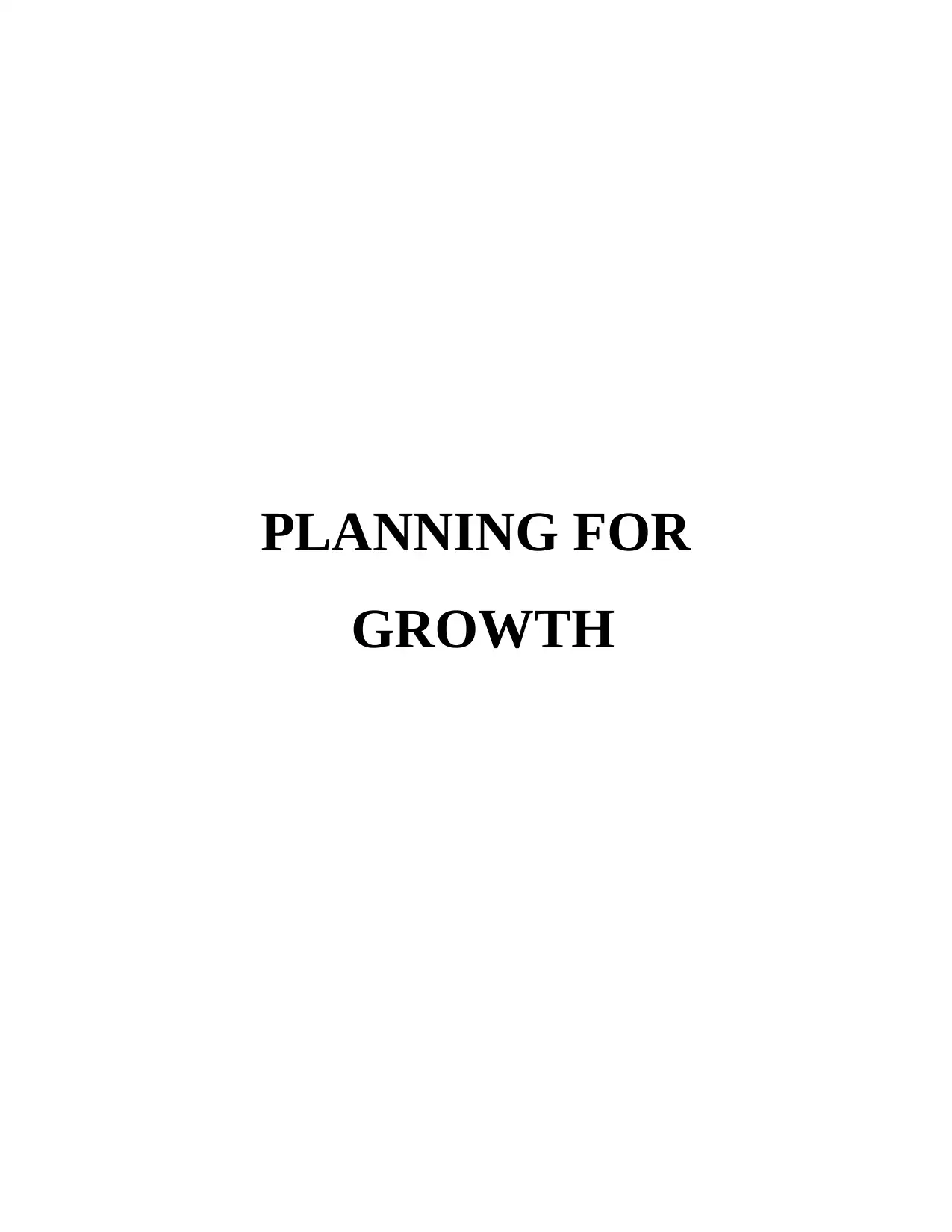
PLANNING FOR
GROWTH
GROWTH
Secure Best Marks with AI Grader
Need help grading? Try our AI Grader for instant feedback on your assignments.
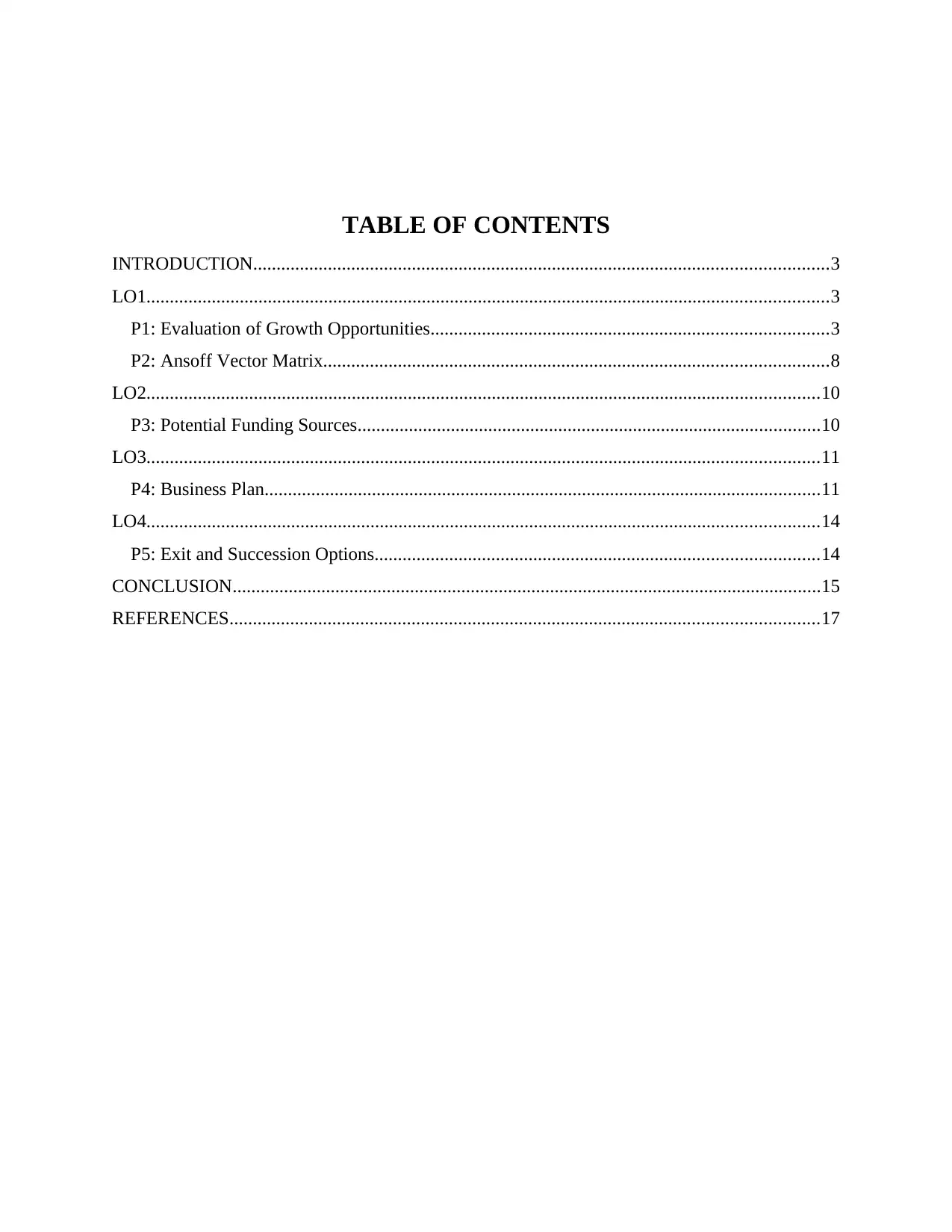
TABLE OF CONTENTS
INTRODUCTION...........................................................................................................................3
LO1..................................................................................................................................................3
P1: Evaluation of Growth Opportunities.....................................................................................3
P2: Ansoff Vector Matrix............................................................................................................8
LO2................................................................................................................................................10
P3: Potential Funding Sources...................................................................................................10
LO3................................................................................................................................................11
P4: Business Plan.......................................................................................................................11
LO4................................................................................................................................................14
P5: Exit and Succession Options...............................................................................................14
CONCLUSION..............................................................................................................................15
REFERENCES..............................................................................................................................17
INTRODUCTION...........................................................................................................................3
LO1..................................................................................................................................................3
P1: Evaluation of Growth Opportunities.....................................................................................3
P2: Ansoff Vector Matrix............................................................................................................8
LO2................................................................................................................................................10
P3: Potential Funding Sources...................................................................................................10
LO3................................................................................................................................................11
P4: Business Plan.......................................................................................................................11
LO4................................................................................................................................................14
P5: Exit and Succession Options...............................................................................................14
CONCLUSION..............................................................................................................................15
REFERENCES..............................................................................................................................17
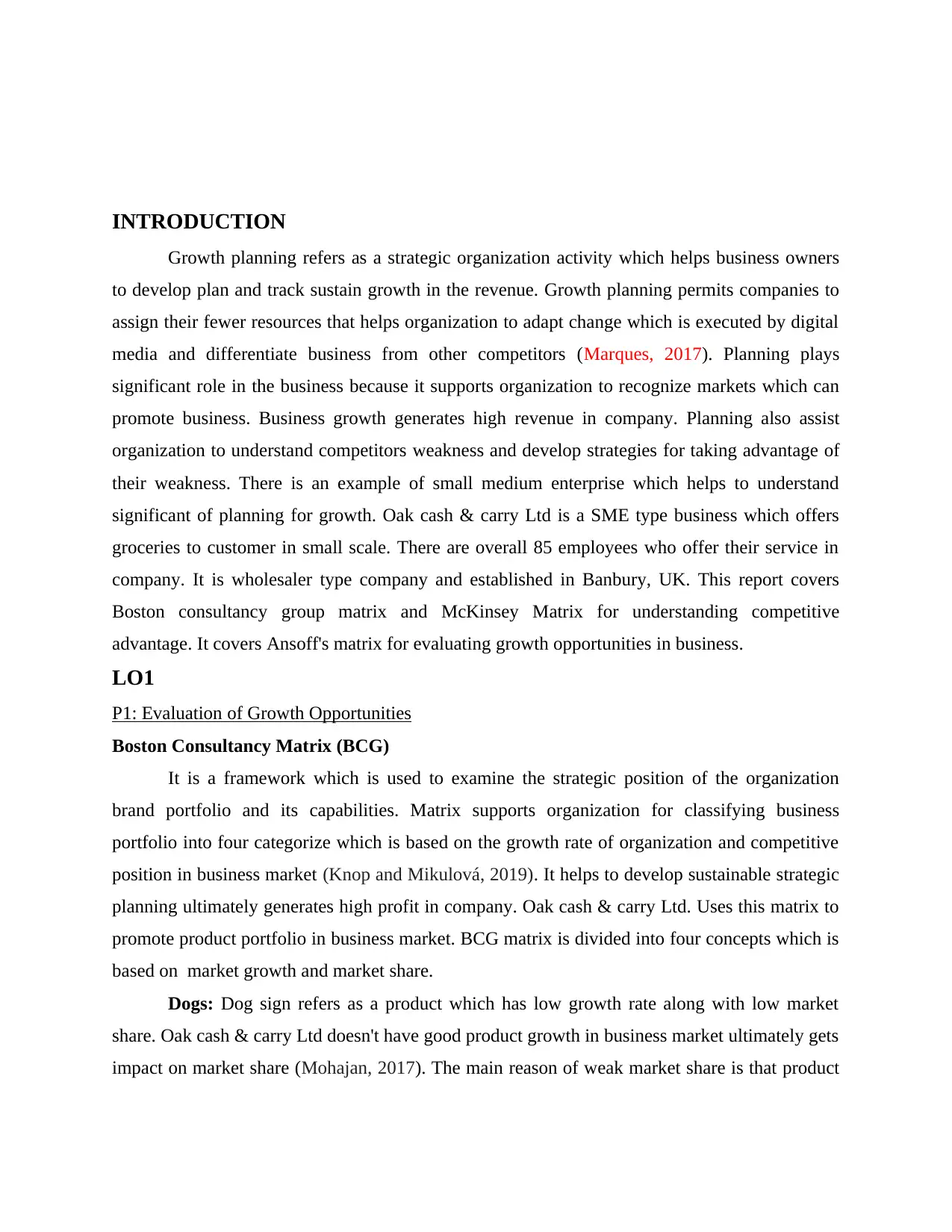
INTRODUCTION
Growth planning refers as a strategic organization activity which helps business owners
to develop plan and track sustain growth in the revenue. Growth planning permits companies to
assign their fewer resources that helps organization to adapt change which is executed by digital
media and differentiate business from other competitors (Marques, 2017). Planning plays
significant role in the business because it supports organization to recognize markets which can
promote business. Business growth generates high revenue in company. Planning also assist
organization to understand competitors weakness and develop strategies for taking advantage of
their weakness. There is an example of small medium enterprise which helps to understand
significant of planning for growth. Oak cash & carry Ltd is a SME type business which offers
groceries to customer in small scale. There are overall 85 employees who offer their service in
company. It is wholesaler type company and established in Banbury, UK. This report covers
Boston consultancy group matrix and McKinsey Matrix for understanding competitive
advantage. It covers Ansoff's matrix for evaluating growth opportunities in business.
LO1
P1: Evaluation of Growth Opportunities
Boston Consultancy Matrix (BCG)
It is a framework which is used to examine the strategic position of the organization
brand portfolio and its capabilities. Matrix supports organization for classifying business
portfolio into four categorize which is based on the growth rate of organization and competitive
position in business market (Knop and Mikulová, 2019). It helps to develop sustainable strategic
planning ultimately generates high profit in company. Oak cash & carry Ltd. Uses this matrix to
promote product portfolio in business market. BCG matrix is divided into four concepts which is
based on market growth and market share.
Dogs: Dog sign refers as a product which has low growth rate along with low market
share. Oak cash & carry Ltd doesn't have good product growth in business market ultimately gets
impact on market share (Mohajan, 2017). The main reason of weak market share is that product
Growth planning refers as a strategic organization activity which helps business owners
to develop plan and track sustain growth in the revenue. Growth planning permits companies to
assign their fewer resources that helps organization to adapt change which is executed by digital
media and differentiate business from other competitors (Marques, 2017). Planning plays
significant role in the business because it supports organization to recognize markets which can
promote business. Business growth generates high revenue in company. Planning also assist
organization to understand competitors weakness and develop strategies for taking advantage of
their weakness. There is an example of small medium enterprise which helps to understand
significant of planning for growth. Oak cash & carry Ltd is a SME type business which offers
groceries to customer in small scale. There are overall 85 employees who offer their service in
company. It is wholesaler type company and established in Banbury, UK. This report covers
Boston consultancy group matrix and McKinsey Matrix for understanding competitive
advantage. It covers Ansoff's matrix for evaluating growth opportunities in business.
LO1
P1: Evaluation of Growth Opportunities
Boston Consultancy Matrix (BCG)
It is a framework which is used to examine the strategic position of the organization
brand portfolio and its capabilities. Matrix supports organization for classifying business
portfolio into four categorize which is based on the growth rate of organization and competitive
position in business market (Knop and Mikulová, 2019). It helps to develop sustainable strategic
planning ultimately generates high profit in company. Oak cash & carry Ltd. Uses this matrix to
promote product portfolio in business market. BCG matrix is divided into four concepts which is
based on market growth and market share.
Dogs: Dog sign refers as a product which has low growth rate along with low market
share. Oak cash & carry Ltd doesn't have good product growth in business market ultimately gets
impact on market share (Mohajan, 2017). The main reason of weak market share is that product
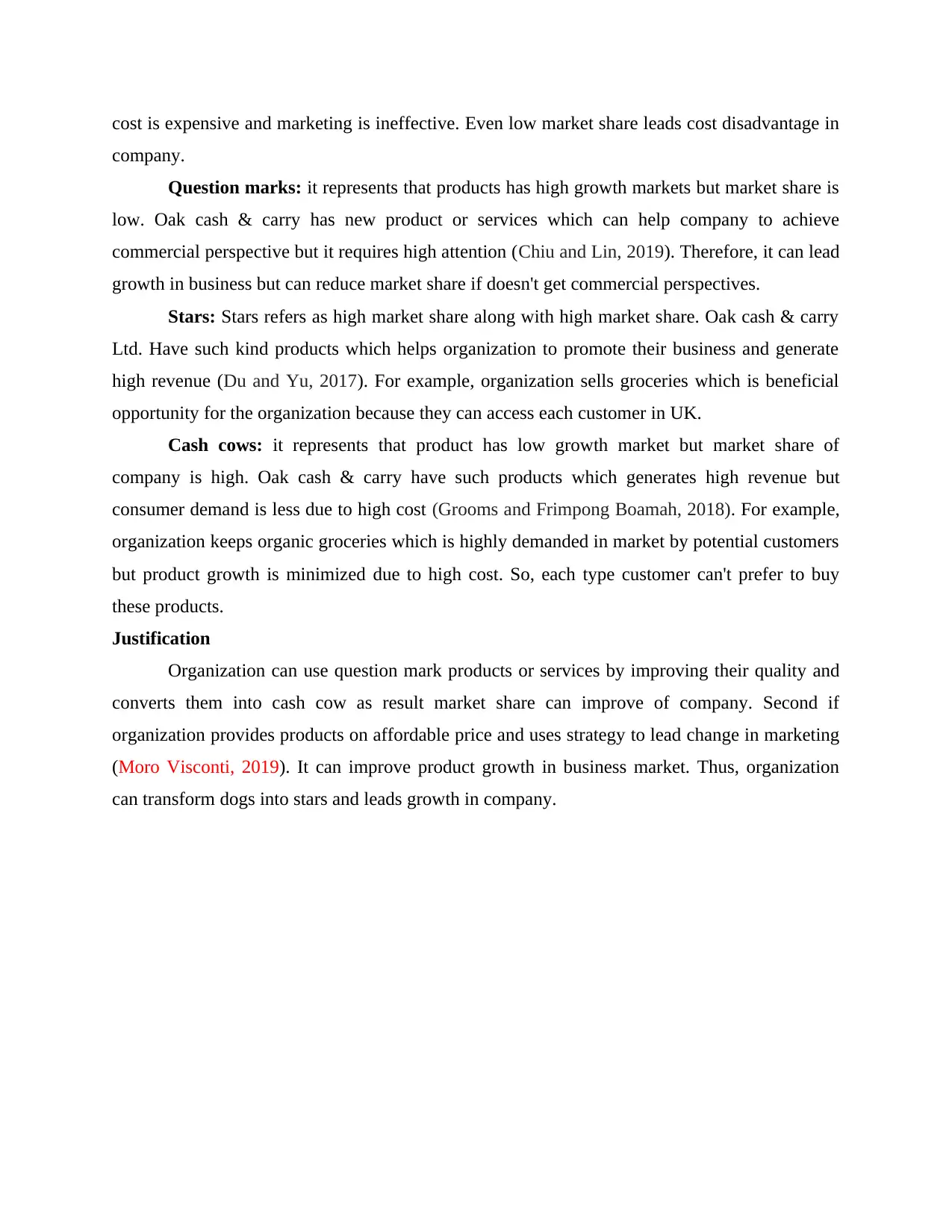
cost is expensive and marketing is ineffective. Even low market share leads cost disadvantage in
company.
Question marks: it represents that products has high growth markets but market share is
low. Oak cash & carry has new product or services which can help company to achieve
commercial perspective but it requires high attention (Chiu and Lin, 2019). Therefore, it can lead
growth in business but can reduce market share if doesn't get commercial perspectives.
Stars: Stars refers as high market share along with high market share. Oak cash & carry
Ltd. Have such kind products which helps organization to promote their business and generate
high revenue (Du and Yu, 2017). For example, organization sells groceries which is beneficial
opportunity for the organization because they can access each customer in UK.
Cash cows: it represents that product has low growth market but market share of
company is high. Oak cash & carry have such products which generates high revenue but
consumer demand is less due to high cost (Grooms and Frimpong Boamah, 2018). For example,
organization keeps organic groceries which is highly demanded in market by potential customers
but product growth is minimized due to high cost. So, each type customer can't prefer to buy
these products.
Justification
Organization can use question mark products or services by improving their quality and
converts them into cash cow as result market share can improve of company. Second if
organization provides products on affordable price and uses strategy to lead change in marketing
(Moro Visconti, 2019). It can improve product growth in business market. Thus, organization
can transform dogs into stars and leads growth in company.
company.
Question marks: it represents that products has high growth markets but market share is
low. Oak cash & carry has new product or services which can help company to achieve
commercial perspective but it requires high attention (Chiu and Lin, 2019). Therefore, it can lead
growth in business but can reduce market share if doesn't get commercial perspectives.
Stars: Stars refers as high market share along with high market share. Oak cash & carry
Ltd. Have such kind products which helps organization to promote their business and generate
high revenue (Du and Yu, 2017). For example, organization sells groceries which is beneficial
opportunity for the organization because they can access each customer in UK.
Cash cows: it represents that product has low growth market but market share of
company is high. Oak cash & carry have such products which generates high revenue but
consumer demand is less due to high cost (Grooms and Frimpong Boamah, 2018). For example,
organization keeps organic groceries which is highly demanded in market by potential customers
but product growth is minimized due to high cost. So, each type customer can't prefer to buy
these products.
Justification
Organization can use question mark products or services by improving their quality and
converts them into cash cow as result market share can improve of company. Second if
organization provides products on affordable price and uses strategy to lead change in marketing
(Moro Visconti, 2019). It can improve product growth in business market. Thus, organization
can transform dogs into stars and leads growth in company.
Secure Best Marks with AI Grader
Need help grading? Try our AI Grader for instant feedback on your assignments.

GE/McKinsey Matrix
It is systematic tool which examines business portfolio and offers strategic implication
and supports organization to understand investment needs for further growth. It is based
on two factors industry attractiveness and competitive strength (Rahman and et.al.,
2018). Oak cash & carry Ltd. Uses this model for influencing product growth and
market share in business market. It is described below:
Illustration 1: BCG Matrix
Source: (BCG Matrix. 2016)
It is systematic tool which examines business portfolio and offers strategic implication
and supports organization to understand investment needs for further growth. It is based
on two factors industry attractiveness and competitive strength (Rahman and et.al.,
2018). Oak cash & carry Ltd. Uses this model for influencing product growth and
market share in business market. It is described below:
Illustration 1: BCG Matrix
Source: (BCG Matrix. 2016)
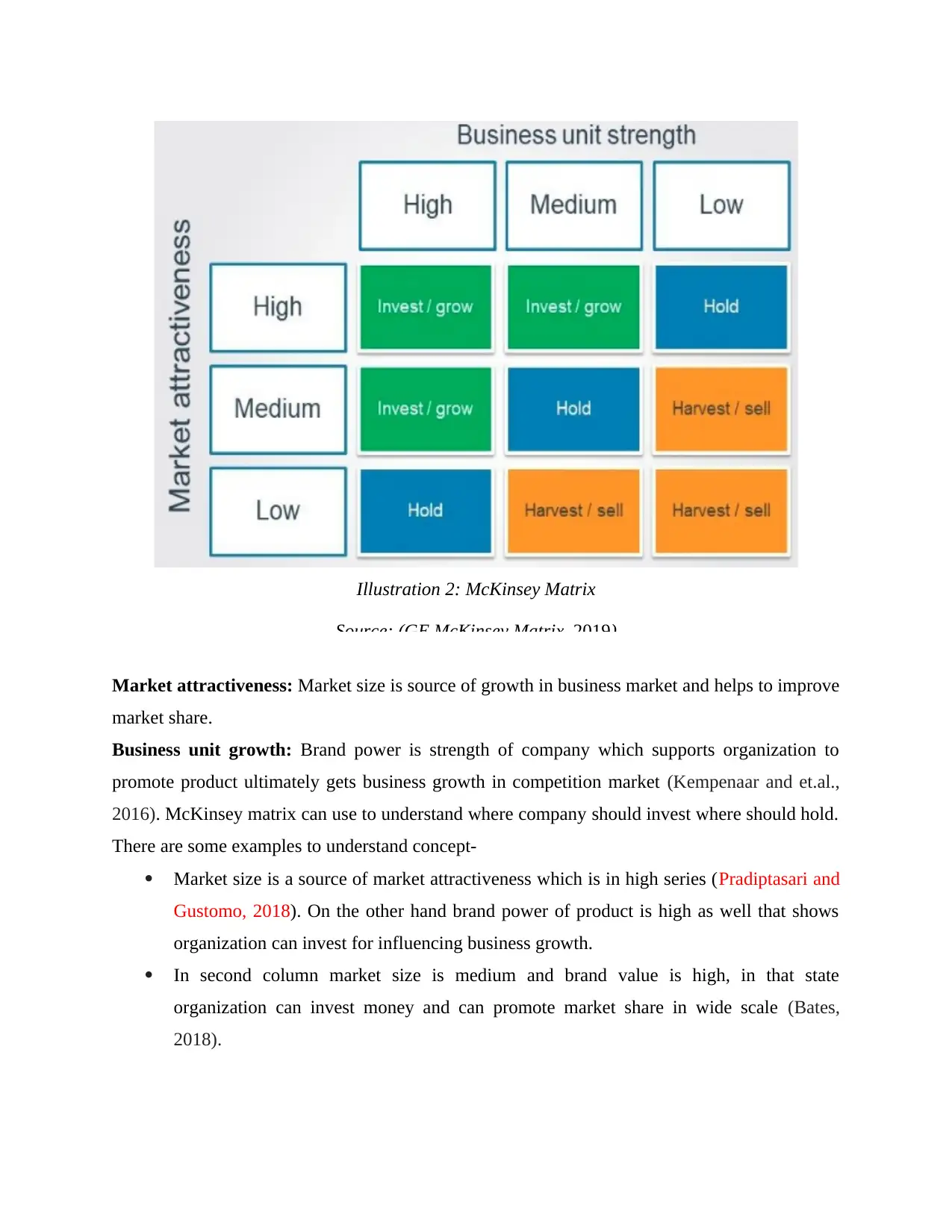
Market attractiveness: Market size is source of growth in business market and helps to improve
market share.
Business unit growth: Brand power is strength of company which supports organization to
promote product ultimately gets business growth in competition market (Kempenaar and et.al.,
2016). McKinsey matrix can use to understand where company should invest where should hold.
There are some examples to understand concept-
Market size is a source of market attractiveness which is in high series (Pradiptasari and
Gustomo, 2018). On the other hand brand power of product is high as well that shows
organization can invest for influencing business growth.
In second column market size is medium and brand value is high, in that state
organization can invest money and can promote market share in wide scale (Bates,
2018).
Illustration 2: McKinsey Matrix
Source: (GE McKinsey Matrix. 2019)
market share.
Business unit growth: Brand power is strength of company which supports organization to
promote product ultimately gets business growth in competition market (Kempenaar and et.al.,
2016). McKinsey matrix can use to understand where company should invest where should hold.
There are some examples to understand concept-
Market size is a source of market attractiveness which is in high series (Pradiptasari and
Gustomo, 2018). On the other hand brand power of product is high as well that shows
organization can invest for influencing business growth.
In second column market size is medium and brand value is high, in that state
organization can invest money and can promote market share in wide scale (Bates,
2018).
Illustration 2: McKinsey Matrix
Source: (GE McKinsey Matrix. 2019)
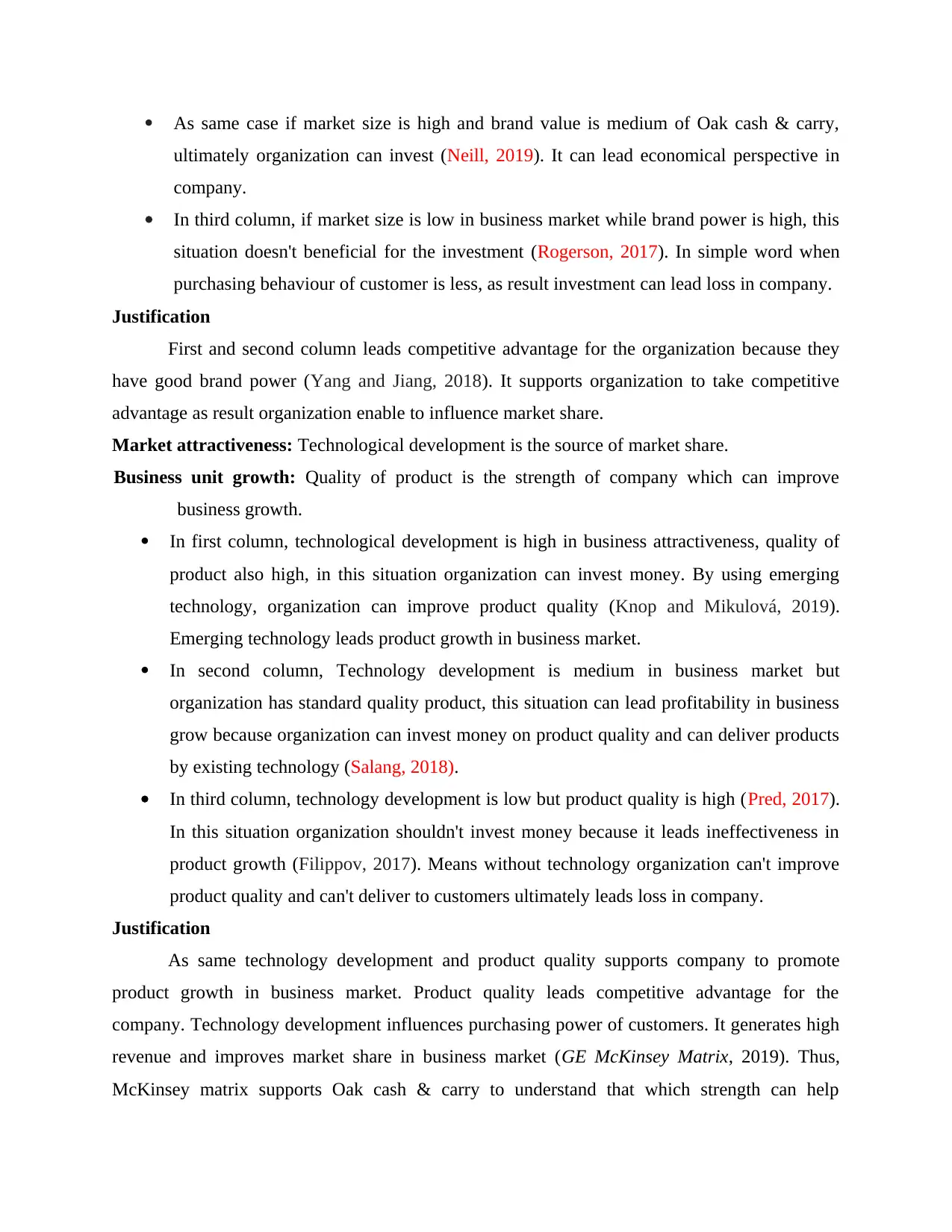
As same case if market size is high and brand value is medium of Oak cash & carry,
ultimately organization can invest (Neill, 2019). It can lead economical perspective in
company.
In third column, if market size is low in business market while brand power is high, this
situation doesn't beneficial for the investment (Rogerson, 2017). In simple word when
purchasing behaviour of customer is less, as result investment can lead loss in company.
Justification
First and second column leads competitive advantage for the organization because they
have good brand power (Yang and Jiang, 2018). It supports organization to take competitive
advantage as result organization enable to influence market share.
Market attractiveness: Technological development is the source of market share.
Business unit growth: Quality of product is the strength of company which can improve
business growth.
In first column, technological development is high in business attractiveness, quality of
product also high, in this situation organization can invest money. By using emerging
technology, organization can improve product quality (Knop and Mikulová, 2019).
Emerging technology leads product growth in business market.
In second column, Technology development is medium in business market but
organization has standard quality product, this situation can lead profitability in business
grow because organization can invest money on product quality and can deliver products
by existing technology (Salang, 2018).
In third column, technology development is low but product quality is high (Pred, 2017).
In this situation organization shouldn't invest money because it leads ineffectiveness in
product growth (Filippov, 2017). Means without technology organization can't improve
product quality and can't deliver to customers ultimately leads loss in company.
Justification
As same technology development and product quality supports company to promote
product growth in business market. Product quality leads competitive advantage for the
company. Technology development influences purchasing power of customers. It generates high
revenue and improves market share in business market (GE McKinsey Matrix, 2019). Thus,
McKinsey matrix supports Oak cash & carry to understand that which strength can help
ultimately organization can invest (Neill, 2019). It can lead economical perspective in
company.
In third column, if market size is low in business market while brand power is high, this
situation doesn't beneficial for the investment (Rogerson, 2017). In simple word when
purchasing behaviour of customer is less, as result investment can lead loss in company.
Justification
First and second column leads competitive advantage for the organization because they
have good brand power (Yang and Jiang, 2018). It supports organization to take competitive
advantage as result organization enable to influence market share.
Market attractiveness: Technological development is the source of market share.
Business unit growth: Quality of product is the strength of company which can improve
business growth.
In first column, technological development is high in business attractiveness, quality of
product also high, in this situation organization can invest money. By using emerging
technology, organization can improve product quality (Knop and Mikulová, 2019).
Emerging technology leads product growth in business market.
In second column, Technology development is medium in business market but
organization has standard quality product, this situation can lead profitability in business
grow because organization can invest money on product quality and can deliver products
by existing technology (Salang, 2018).
In third column, technology development is low but product quality is high (Pred, 2017).
In this situation organization shouldn't invest money because it leads ineffectiveness in
product growth (Filippov, 2017). Means without technology organization can't improve
product quality and can't deliver to customers ultimately leads loss in company.
Justification
As same technology development and product quality supports company to promote
product growth in business market. Product quality leads competitive advantage for the
company. Technology development influences purchasing power of customers. It generates high
revenue and improves market share in business market (GE McKinsey Matrix, 2019). Thus,
McKinsey matrix supports Oak cash & carry to understand that which strength can help
Paraphrase This Document
Need a fresh take? Get an instant paraphrase of this document with our AI Paraphraser
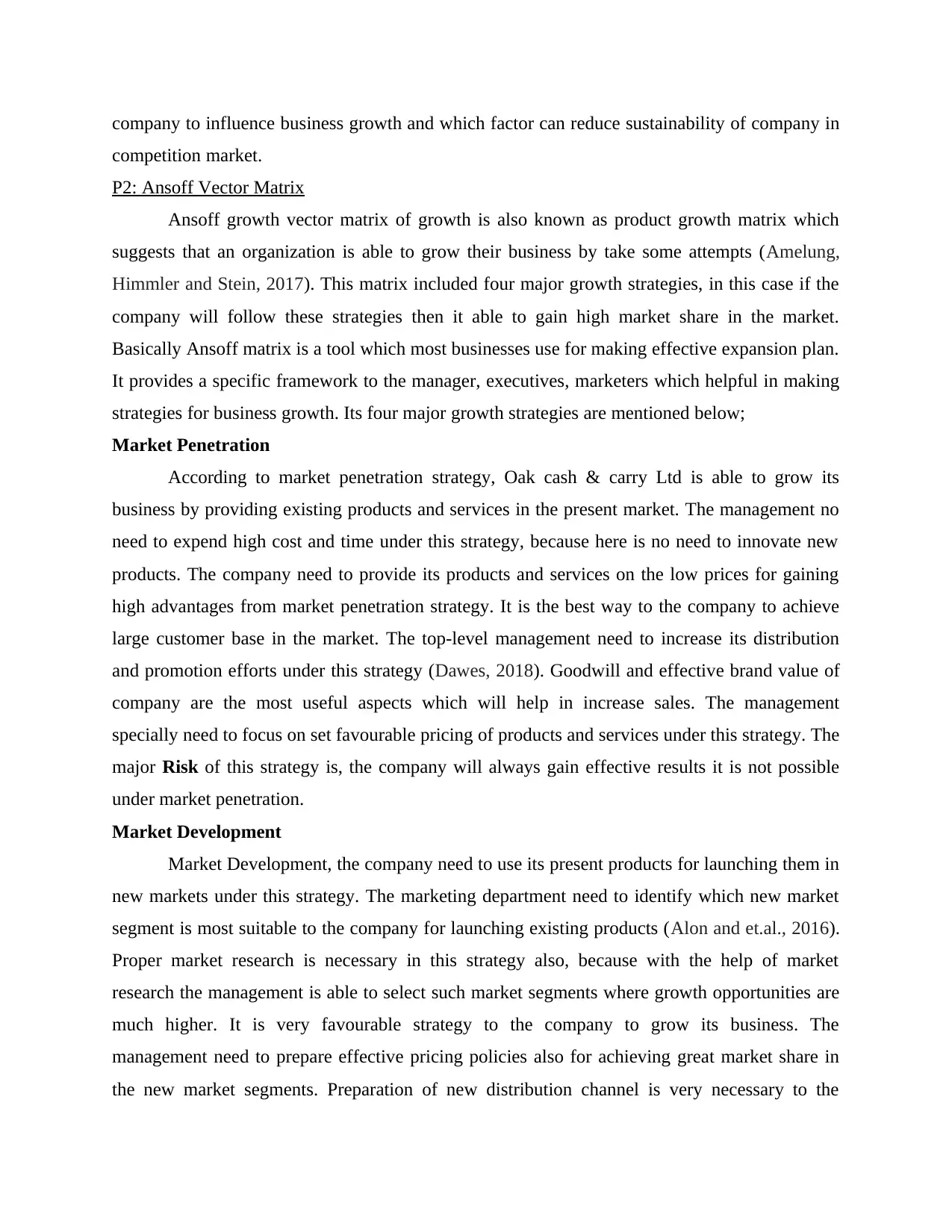
company to influence business growth and which factor can reduce sustainability of company in
competition market.
P2: Ansoff Vector Matrix
Ansoff growth vector matrix of growth is also known as product growth matrix which
suggests that an organization is able to grow their business by take some attempts (Amelung,
Himmler and Stein, 2017). This matrix included four major growth strategies, in this case if the
company will follow these strategies then it able to gain high market share in the market.
Basically Ansoff matrix is a tool which most businesses use for making effective expansion plan.
It provides a specific framework to the manager, executives, marketers which helpful in making
strategies for business growth. Its four major growth strategies are mentioned below;
Market Penetration
According to market penetration strategy, Oak cash & carry Ltd is able to grow its
business by providing existing products and services in the present market. The management no
need to expend high cost and time under this strategy, because here is no need to innovate new
products. The company need to provide its products and services on the low prices for gaining
high advantages from market penetration strategy. It is the best way to the company to achieve
large customer base in the market. The top-level management need to increase its distribution
and promotion efforts under this strategy (Dawes, 2018). Goodwill and effective brand value of
company are the most useful aspects which will help in increase sales. The management
specially need to focus on set favourable pricing of products and services under this strategy. The
major Risk of this strategy is, the company will always gain effective results it is not possible
under market penetration.
Market Development
Market Development, the company need to use its present products for launching them in
new markets under this strategy. The marketing department need to identify which new market
segment is most suitable to the company for launching existing products (Alon and et.al., 2016).
Proper market research is necessary in this strategy also, because with the help of market
research the management is able to select such market segments where growth opportunities are
much higher. It is very favourable strategy to the company to grow its business. The
management need to prepare effective pricing policies also for achieving great market share in
the new market segments. Preparation of new distribution channel is very necessary to the
competition market.
P2: Ansoff Vector Matrix
Ansoff growth vector matrix of growth is also known as product growth matrix which
suggests that an organization is able to grow their business by take some attempts (Amelung,
Himmler and Stein, 2017). This matrix included four major growth strategies, in this case if the
company will follow these strategies then it able to gain high market share in the market.
Basically Ansoff matrix is a tool which most businesses use for making effective expansion plan.
It provides a specific framework to the manager, executives, marketers which helpful in making
strategies for business growth. Its four major growth strategies are mentioned below;
Market Penetration
According to market penetration strategy, Oak cash & carry Ltd is able to grow its
business by providing existing products and services in the present market. The management no
need to expend high cost and time under this strategy, because here is no need to innovate new
products. The company need to provide its products and services on the low prices for gaining
high advantages from market penetration strategy. It is the best way to the company to achieve
large customer base in the market. The top-level management need to increase its distribution
and promotion efforts under this strategy (Dawes, 2018). Goodwill and effective brand value of
company are the most useful aspects which will help in increase sales. The management
specially need to focus on set favourable pricing of products and services under this strategy. The
major Risk of this strategy is, the company will always gain effective results it is not possible
under market penetration.
Market Development
Market Development, the company need to use its present products for launching them in
new markets under this strategy. The marketing department need to identify which new market
segment is most suitable to the company for launching existing products (Alon and et.al., 2016).
Proper market research is necessary in this strategy also, because with the help of market
research the management is able to select such market segments where growth opportunities are
much higher. It is very favourable strategy to the company to grow its business. The
management need to prepare effective pricing policies also for achieving great market share in
the new market segments. Preparation of new distribution channel is very necessary to the
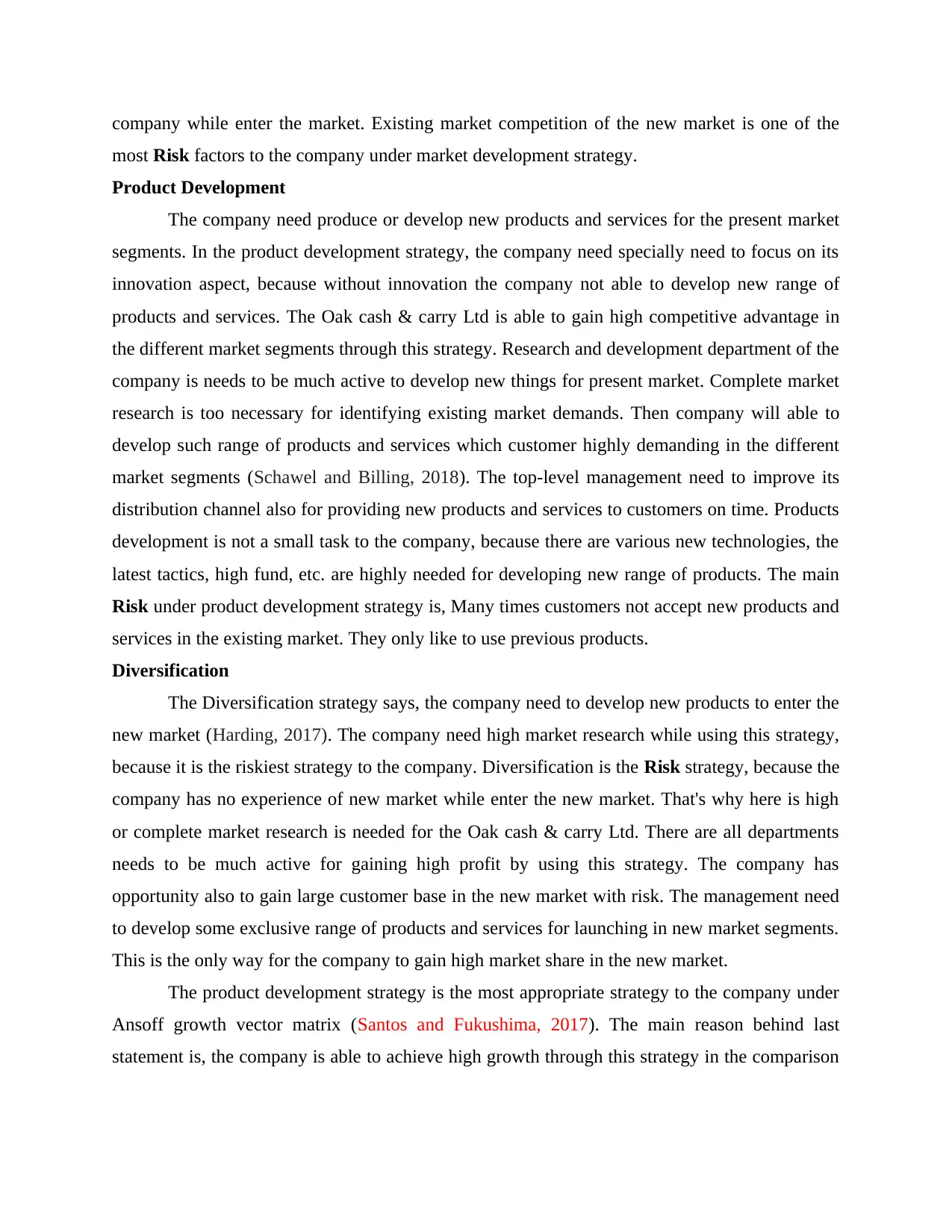
company while enter the market. Existing market competition of the new market is one of the
most Risk factors to the company under market development strategy.
Product Development
The company need produce or develop new products and services for the present market
segments. In the product development strategy, the company need specially need to focus on its
innovation aspect, because without innovation the company not able to develop new range of
products and services. The Oak cash & carry Ltd is able to gain high competitive advantage in
the different market segments through this strategy. Research and development department of the
company is needs to be much active to develop new things for present market. Complete market
research is too necessary for identifying existing market demands. Then company will able to
develop such range of products and services which customer highly demanding in the different
market segments (Schawel and Billing, 2018). The top-level management need to improve its
distribution channel also for providing new products and services to customers on time. Products
development is not a small task to the company, because there are various new technologies, the
latest tactics, high fund, etc. are highly needed for developing new range of products. The main
Risk under product development strategy is, Many times customers not accept new products and
services in the existing market. They only like to use previous products.
Diversification
The Diversification strategy says, the company need to develop new products to enter the
new market (Harding, 2017). The company need high market research while using this strategy,
because it is the riskiest strategy to the company. Diversification is the Risk strategy, because the
company has no experience of new market while enter the new market. That's why here is high
or complete market research is needed for the Oak cash & carry Ltd. There are all departments
needs to be much active for gaining high profit by using this strategy. The company has
opportunity also to gain large customer base in the new market with risk. The management need
to develop some exclusive range of products and services for launching in new market segments.
This is the only way for the company to gain high market share in the new market.
The product development strategy is the most appropriate strategy to the company under
Ansoff growth vector matrix (Santos and Fukushima, 2017). The main reason behind last
statement is, the company is able to achieve high growth through this strategy in the comparison
most Risk factors to the company under market development strategy.
Product Development
The company need produce or develop new products and services for the present market
segments. In the product development strategy, the company need specially need to focus on its
innovation aspect, because without innovation the company not able to develop new range of
products and services. The Oak cash & carry Ltd is able to gain high competitive advantage in
the different market segments through this strategy. Research and development department of the
company is needs to be much active to develop new things for present market. Complete market
research is too necessary for identifying existing market demands. Then company will able to
develop such range of products and services which customer highly demanding in the different
market segments (Schawel and Billing, 2018). The top-level management need to improve its
distribution channel also for providing new products and services to customers on time. Products
development is not a small task to the company, because there are various new technologies, the
latest tactics, high fund, etc. are highly needed for developing new range of products. The main
Risk under product development strategy is, Many times customers not accept new products and
services in the existing market. They only like to use previous products.
Diversification
The Diversification strategy says, the company need to develop new products to enter the
new market (Harding, 2017). The company need high market research while using this strategy,
because it is the riskiest strategy to the company. Diversification is the Risk strategy, because the
company has no experience of new market while enter the new market. That's why here is high
or complete market research is needed for the Oak cash & carry Ltd. There are all departments
needs to be much active for gaining high profit by using this strategy. The company has
opportunity also to gain large customer base in the new market with risk. The management need
to develop some exclusive range of products and services for launching in new market segments.
This is the only way for the company to gain high market share in the new market.
The product development strategy is the most appropriate strategy to the company under
Ansoff growth vector matrix (Santos and Fukushima, 2017). The main reason behind last
statement is, the company is able to achieve high growth through this strategy in the comparison

of other strategies. Under product development strategy, the management only need to provide
new products with good quality in the existing market segments.
LO2
P3: Potential Funding Sources
Funding sources are basically such sources to the any business which help them in rising
specific fund in the market. Some major potential funding sources are mentioned below;
1. Bank Loans: Banks loans are one of the most popular source of funding. There are banks
providing loans to the all type of businesses in both manner short terms loans and long
term loans (Rawitzer and Hefti, 2016). In case when any business want some fund for
grow their business then it able to take or rise fund through banks. Many SMEs and large
businesses taking great advantages from this funding source, because banks are currently
existing in any place. There are all banks not provide loans on same interest rates,
because all has their own terms and conditions on loans. In this case, a business need to
find such banks in the market which offers the lowest interest rates on loans. Bank loans
are mainly short term debt to the any business owner, it is the biggest benefit of this
source. In other side, a business owner need to fulfil many complicated formalities while
taking loans from banks. So, it is the main drawback of banks loans.
2. Investors: Investors are also good option to the businesses for gain or rise fund. There
are many types of investors available in the market who interested in investing different
industries (Staniewski, Szopiński and Awruk, 2016). In this case, the owner of business
need to identify such investors in the market who ready to invest in their business.
Investors are really very potential source of funding, because a business no need to put
many efforts to gain fund from them. The main task to the business owner is to convince
these investors to invest in own business. In case once these investors become satisfied
with conditions of business, then they will easily invest in owner's business. Owner no
need to fulfil complicated paper work formalities like bank loans in while taking fund
from investors. It is the main benefit of this source. In other side, owner will lost their
full ownership of business when it takes fund from investors. It is the drawback of this
funding source.
3. Family Members and Friends: It is also the most popular source of funding to the
businesses. An owner is able to take specific fund from their family members and friends.
new products with good quality in the existing market segments.
LO2
P3: Potential Funding Sources
Funding sources are basically such sources to the any business which help them in rising
specific fund in the market. Some major potential funding sources are mentioned below;
1. Bank Loans: Banks loans are one of the most popular source of funding. There are banks
providing loans to the all type of businesses in both manner short terms loans and long
term loans (Rawitzer and Hefti, 2016). In case when any business want some fund for
grow their business then it able to take or rise fund through banks. Many SMEs and large
businesses taking great advantages from this funding source, because banks are currently
existing in any place. There are all banks not provide loans on same interest rates,
because all has their own terms and conditions on loans. In this case, a business need to
find such banks in the market which offers the lowest interest rates on loans. Bank loans
are mainly short term debt to the any business owner, it is the biggest benefit of this
source. In other side, a business owner need to fulfil many complicated formalities while
taking loans from banks. So, it is the main drawback of banks loans.
2. Investors: Investors are also good option to the businesses for gain or rise fund. There
are many types of investors available in the market who interested in investing different
industries (Staniewski, Szopiński and Awruk, 2016). In this case, the owner of business
need to identify such investors in the market who ready to invest in their business.
Investors are really very potential source of funding, because a business no need to put
many efforts to gain fund from them. The main task to the business owner is to convince
these investors to invest in own business. In case once these investors become satisfied
with conditions of business, then they will easily invest in owner's business. Owner no
need to fulfil complicated paper work formalities like bank loans in while taking fund
from investors. It is the main benefit of this source. In other side, owner will lost their
full ownership of business when it takes fund from investors. It is the drawback of this
funding source.
3. Family Members and Friends: It is also the most popular source of funding to the
businesses. An owner is able to take specific fund from their family members and friends.
Secure Best Marks with AI Grader
Need help grading? Try our AI Grader for instant feedback on your assignments.
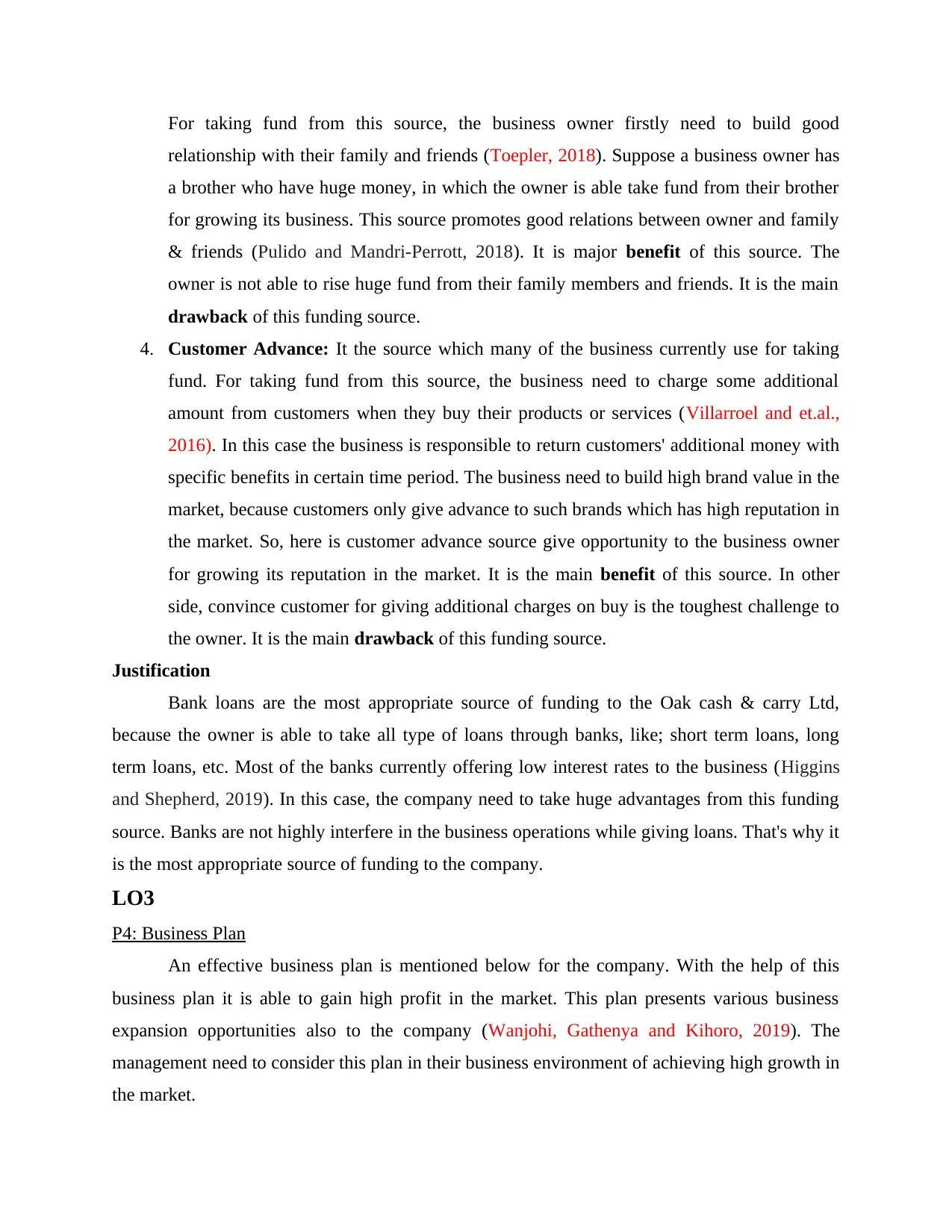
For taking fund from this source, the business owner firstly need to build good
relationship with their family and friends (Toepler, 2018). Suppose a business owner has
a brother who have huge money, in which the owner is able take fund from their brother
for growing its business. This source promotes good relations between owner and family
& friends (Pulido and Mandri-Perrott, 2018). It is major benefit of this source. The
owner is not able to rise huge fund from their family members and friends. It is the main
drawback of this funding source.
4. Customer Advance: It the source which many of the business currently use for taking
fund. For taking fund from this source, the business need to charge some additional
amount from customers when they buy their products or services (Villarroel and et.al.,
2016). In this case the business is responsible to return customers' additional money with
specific benefits in certain time period. The business need to build high brand value in the
market, because customers only give advance to such brands which has high reputation in
the market. So, here is customer advance source give opportunity to the business owner
for growing its reputation in the market. It is the main benefit of this source. In other
side, convince customer for giving additional charges on buy is the toughest challenge to
the owner. It is the main drawback of this funding source.
Justification
Bank loans are the most appropriate source of funding to the Oak cash & carry Ltd,
because the owner is able to take all type of loans through banks, like; short term loans, long
term loans, etc. Most of the banks currently offering low interest rates to the business (Higgins
and Shepherd, 2019). In this case, the company need to take huge advantages from this funding
source. Banks are not highly interfere in the business operations while giving loans. That's why it
is the most appropriate source of funding to the company.
LO3
P4: Business Plan
An effective business plan is mentioned below for the company. With the help of this
business plan it is able to gain high profit in the market. This plan presents various business
expansion opportunities also to the company (Wanjohi, Gathenya and Kihoro, 2019). The
management need to consider this plan in their business environment of achieving high growth in
the market.
relationship with their family and friends (Toepler, 2018). Suppose a business owner has
a brother who have huge money, in which the owner is able take fund from their brother
for growing its business. This source promotes good relations between owner and family
& friends (Pulido and Mandri-Perrott, 2018). It is major benefit of this source. The
owner is not able to rise huge fund from their family members and friends. It is the main
drawback of this funding source.
4. Customer Advance: It the source which many of the business currently use for taking
fund. For taking fund from this source, the business need to charge some additional
amount from customers when they buy their products or services (Villarroel and et.al.,
2016). In this case the business is responsible to return customers' additional money with
specific benefits in certain time period. The business need to build high brand value in the
market, because customers only give advance to such brands which has high reputation in
the market. So, here is customer advance source give opportunity to the business owner
for growing its reputation in the market. It is the main benefit of this source. In other
side, convince customer for giving additional charges on buy is the toughest challenge to
the owner. It is the main drawback of this funding source.
Justification
Bank loans are the most appropriate source of funding to the Oak cash & carry Ltd,
because the owner is able to take all type of loans through banks, like; short term loans, long
term loans, etc. Most of the banks currently offering low interest rates to the business (Higgins
and Shepherd, 2019). In this case, the company need to take huge advantages from this funding
source. Banks are not highly interfere in the business operations while giving loans. That's why it
is the most appropriate source of funding to the company.
LO3
P4: Business Plan
An effective business plan is mentioned below for the company. With the help of this
business plan it is able to gain high profit in the market. This plan presents various business
expansion opportunities also to the company (Wanjohi, Gathenya and Kihoro, 2019). The
management need to consider this plan in their business environment of achieving high growth in
the market.
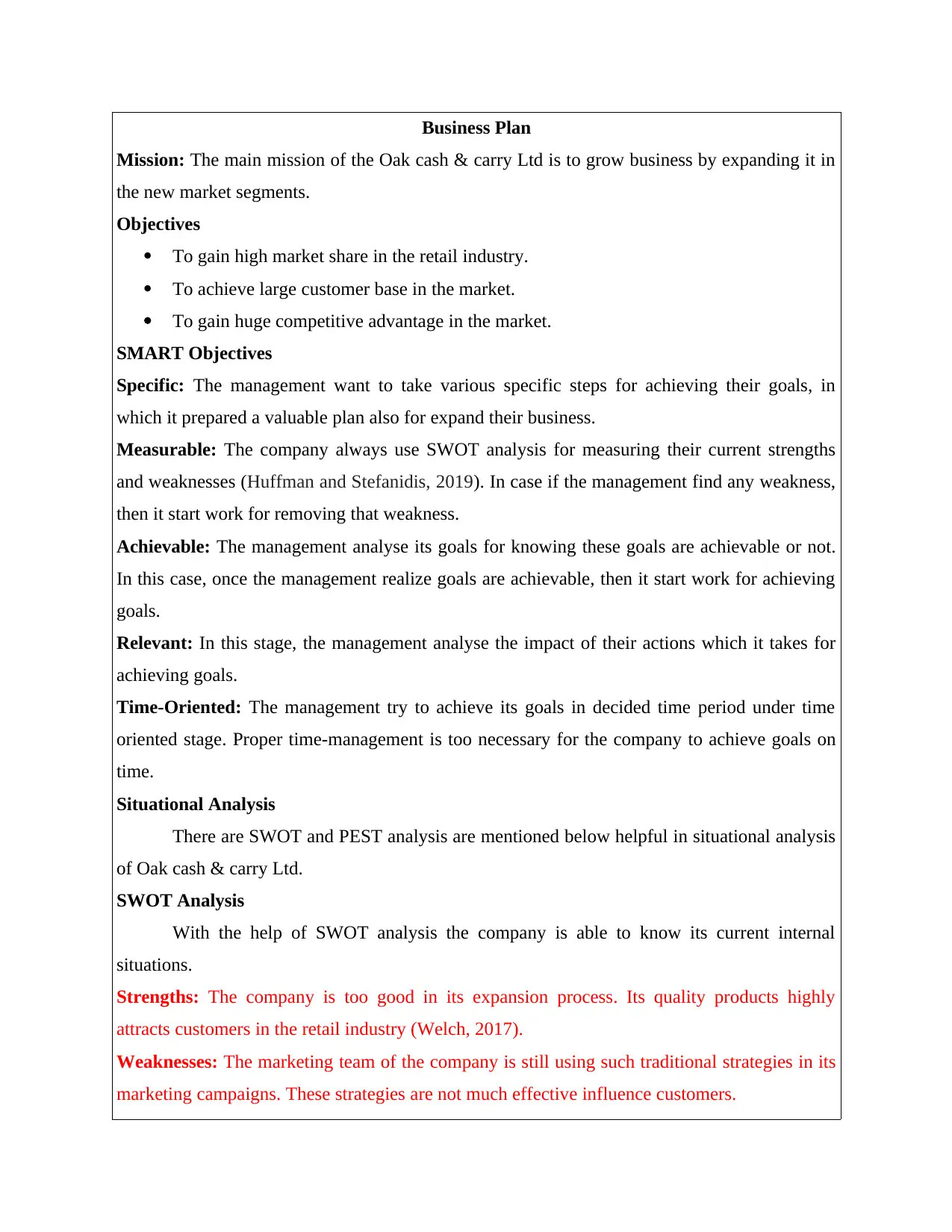
Business Plan
Mission: The main mission of the Oak cash & carry Ltd is to grow business by expanding it in
the new market segments.
Objectives
To gain high market share in the retail industry.
To achieve large customer base in the market.
To gain huge competitive advantage in the market.
SMART Objectives
Specific: The management want to take various specific steps for achieving their goals, in
which it prepared a valuable plan also for expand their business.
Measurable: The company always use SWOT analysis for measuring their current strengths
and weaknesses (Huffman and Stefanidis, 2019). In case if the management find any weakness,
then it start work for removing that weakness.
Achievable: The management analyse its goals for knowing these goals are achievable or not.
In this case, once the management realize goals are achievable, then it start work for achieving
goals.
Relevant: In this stage, the management analyse the impact of their actions which it takes for
achieving goals.
Time-Oriented: The management try to achieve its goals in decided time period under time
oriented stage. Proper time-management is too necessary for the company to achieve goals on
time.
Situational Analysis
There are SWOT and PEST analysis are mentioned below helpful in situational analysis
of Oak cash & carry Ltd.
SWOT Analysis
With the help of SWOT analysis the company is able to know its current internal
situations.
Strengths: The company is too good in its expansion process. Its quality products highly
attracts customers in the retail industry (Welch, 2017).
Weaknesses: The marketing team of the company is still using such traditional strategies in its
marketing campaigns. These strategies are not much effective influence customers.
Mission: The main mission of the Oak cash & carry Ltd is to grow business by expanding it in
the new market segments.
Objectives
To gain high market share in the retail industry.
To achieve large customer base in the market.
To gain huge competitive advantage in the market.
SMART Objectives
Specific: The management want to take various specific steps for achieving their goals, in
which it prepared a valuable plan also for expand their business.
Measurable: The company always use SWOT analysis for measuring their current strengths
and weaknesses (Huffman and Stefanidis, 2019). In case if the management find any weakness,
then it start work for removing that weakness.
Achievable: The management analyse its goals for knowing these goals are achievable or not.
In this case, once the management realize goals are achievable, then it start work for achieving
goals.
Relevant: In this stage, the management analyse the impact of their actions which it takes for
achieving goals.
Time-Oriented: The management try to achieve its goals in decided time period under time
oriented stage. Proper time-management is too necessary for the company to achieve goals on
time.
Situational Analysis
There are SWOT and PEST analysis are mentioned below helpful in situational analysis
of Oak cash & carry Ltd.
SWOT Analysis
With the help of SWOT analysis the company is able to know its current internal
situations.
Strengths: The company is too good in its expansion process. Its quality products highly
attracts customers in the retail industry (Welch, 2017).
Weaknesses: The marketing team of the company is still using such traditional strategies in its
marketing campaigns. These strategies are not much effective influence customers.
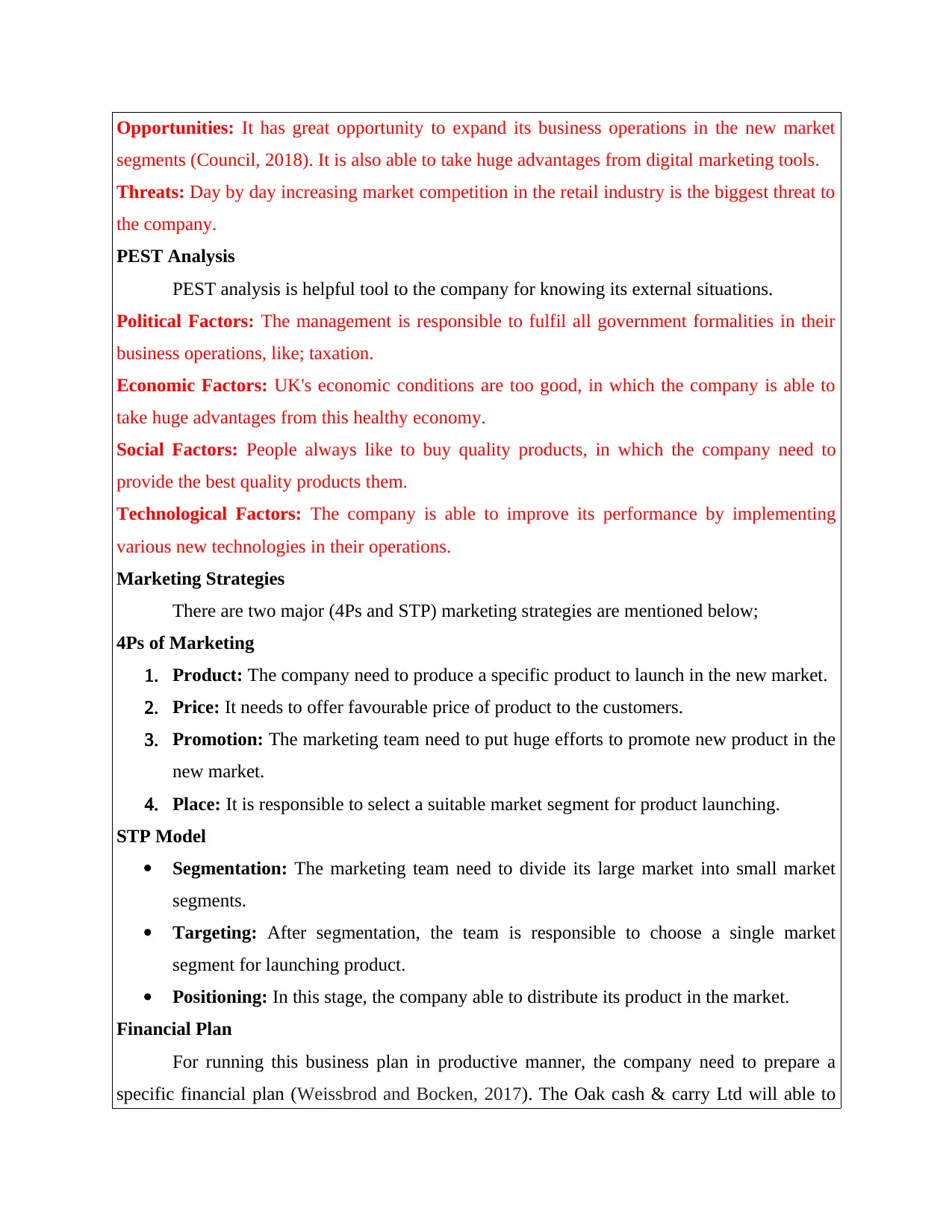
Opportunities: It has great opportunity to expand its business operations in the new market
segments (Council, 2018). It is also able to take huge advantages from digital marketing tools.
Threats: Day by day increasing market competition in the retail industry is the biggest threat to
the company.
PEST Analysis
PEST analysis is helpful tool to the company for knowing its external situations.
Political Factors: The management is responsible to fulfil all government formalities in their
business operations, like; taxation.
Economic Factors: UK's economic conditions are too good, in which the company is able to
take huge advantages from this healthy economy.
Social Factors: People always like to buy quality products, in which the company need to
provide the best quality products them.
Technological Factors: The company is able to improve its performance by implementing
various new technologies in their operations.
Marketing Strategies
There are two major (4Ps and STP) marketing strategies are mentioned below;
4Ps of Marketing
1. Product: The company need to produce a specific product to launch in the new market.
2. Price: It needs to offer favourable price of product to the customers.
3. Promotion: The marketing team need to put huge efforts to promote new product in the
new market.
4. Place: It is responsible to select a suitable market segment for product launching.
STP Model
Segmentation: The marketing team need to divide its large market into small market
segments.
Targeting: After segmentation, the team is responsible to choose a single market
segment for launching product.
Positioning: In this stage, the company able to distribute its product in the market.
Financial Plan
For running this business plan in productive manner, the company need to prepare a
specific financial plan (Weissbrod and Bocken, 2017). The Oak cash & carry Ltd will able to
segments (Council, 2018). It is also able to take huge advantages from digital marketing tools.
Threats: Day by day increasing market competition in the retail industry is the biggest threat to
the company.
PEST Analysis
PEST analysis is helpful tool to the company for knowing its external situations.
Political Factors: The management is responsible to fulfil all government formalities in their
business operations, like; taxation.
Economic Factors: UK's economic conditions are too good, in which the company is able to
take huge advantages from this healthy economy.
Social Factors: People always like to buy quality products, in which the company need to
provide the best quality products them.
Technological Factors: The company is able to improve its performance by implementing
various new technologies in their operations.
Marketing Strategies
There are two major (4Ps and STP) marketing strategies are mentioned below;
4Ps of Marketing
1. Product: The company need to produce a specific product to launch in the new market.
2. Price: It needs to offer favourable price of product to the customers.
3. Promotion: The marketing team need to put huge efforts to promote new product in the
new market.
4. Place: It is responsible to select a suitable market segment for product launching.
STP Model
Segmentation: The marketing team need to divide its large market into small market
segments.
Targeting: After segmentation, the team is responsible to choose a single market
segment for launching product.
Positioning: In this stage, the company able to distribute its product in the market.
Financial Plan
For running this business plan in productive manner, the company need to prepare a
specific financial plan (Weissbrod and Bocken, 2017). The Oak cash & carry Ltd will able to
Paraphrase This Document
Need a fresh take? Get an instant paraphrase of this document with our AI Paraphraser
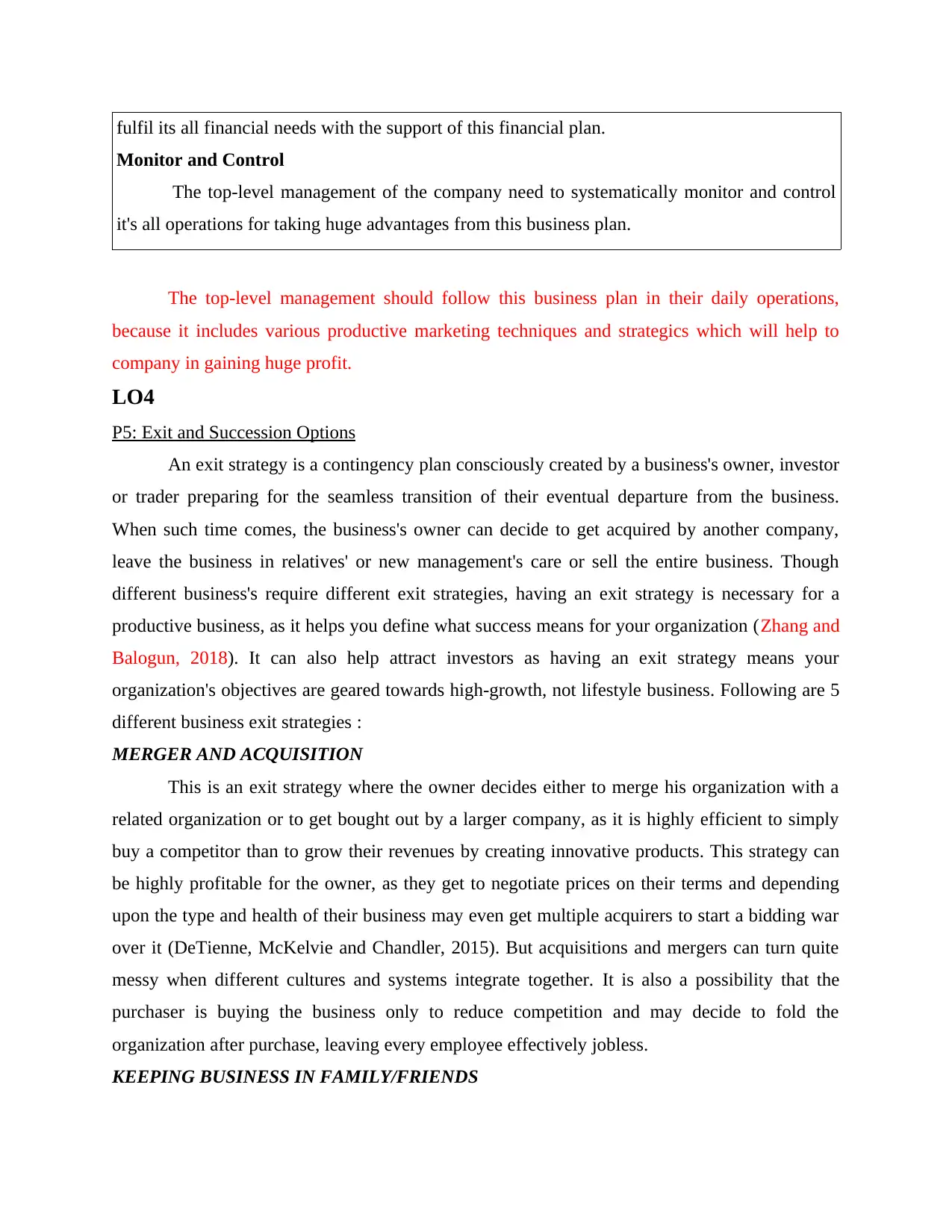
fulfil its all financial needs with the support of this financial plan.
Monitor and Control
The top-level management of the company need to systematically monitor and control
it's all operations for taking huge advantages from this business plan.
The top-level management should follow this business plan in their daily operations,
because it includes various productive marketing techniques and strategics which will help to
company in gaining huge profit.
LO4
P5: Exit and Succession Options
An exit strategy is a contingency plan consciously created by a business's owner, investor
or trader preparing for the seamless transition of their eventual departure from the business.
When such time comes, the business's owner can decide to get acquired by another company,
leave the business in relatives' or new management's care or sell the entire business. Though
different business's require different exit strategies, having an exit strategy is necessary for a
productive business, as it helps you define what success means for your organization (Zhang and
Balogun, 2018). It can also help attract investors as having an exit strategy means your
organization's objectives are geared towards high-growth, not lifestyle business. Following are 5
different business exit strategies :
MERGER AND ACQUISITION
This is an exit strategy where the owner decides either to merge his organization with a
related organization or to get bought out by a larger company, as it is highly efficient to simply
buy a competitor than to grow their revenues by creating innovative products. This strategy can
be highly profitable for the owner, as they get to negotiate prices on their terms and depending
upon the type and health of their business may even get multiple acquirers to start a bidding war
over it (DeTienne, McKelvie and Chandler, 2015). But acquisitions and mergers can turn quite
messy when different cultures and systems integrate together. It is also a possibility that the
purchaser is buying the business only to reduce competition and may decide to fold the
organization after purchase, leaving every employee effectively jobless.
KEEPING BUSINESS IN FAMILY/FRIENDS
Monitor and Control
The top-level management of the company need to systematically monitor and control
it's all operations for taking huge advantages from this business plan.
The top-level management should follow this business plan in their daily operations,
because it includes various productive marketing techniques and strategics which will help to
company in gaining huge profit.
LO4
P5: Exit and Succession Options
An exit strategy is a contingency plan consciously created by a business's owner, investor
or trader preparing for the seamless transition of their eventual departure from the business.
When such time comes, the business's owner can decide to get acquired by another company,
leave the business in relatives' or new management's care or sell the entire business. Though
different business's require different exit strategies, having an exit strategy is necessary for a
productive business, as it helps you define what success means for your organization (Zhang and
Balogun, 2018). It can also help attract investors as having an exit strategy means your
organization's objectives are geared towards high-growth, not lifestyle business. Following are 5
different business exit strategies :
MERGER AND ACQUISITION
This is an exit strategy where the owner decides either to merge his organization with a
related organization or to get bought out by a larger company, as it is highly efficient to simply
buy a competitor than to grow their revenues by creating innovative products. This strategy can
be highly profitable for the owner, as they get to negotiate prices on their terms and depending
upon the type and health of their business may even get multiple acquirers to start a bidding war
over it (DeTienne, McKelvie and Chandler, 2015). But acquisitions and mergers can turn quite
messy when different cultures and systems integrate together. It is also a possibility that the
purchaser is buying the business only to reduce competition and may decide to fold the
organization after purchase, leaving every employee effectively jobless.
KEEPING BUSINESS IN FAMILY/FRIENDS
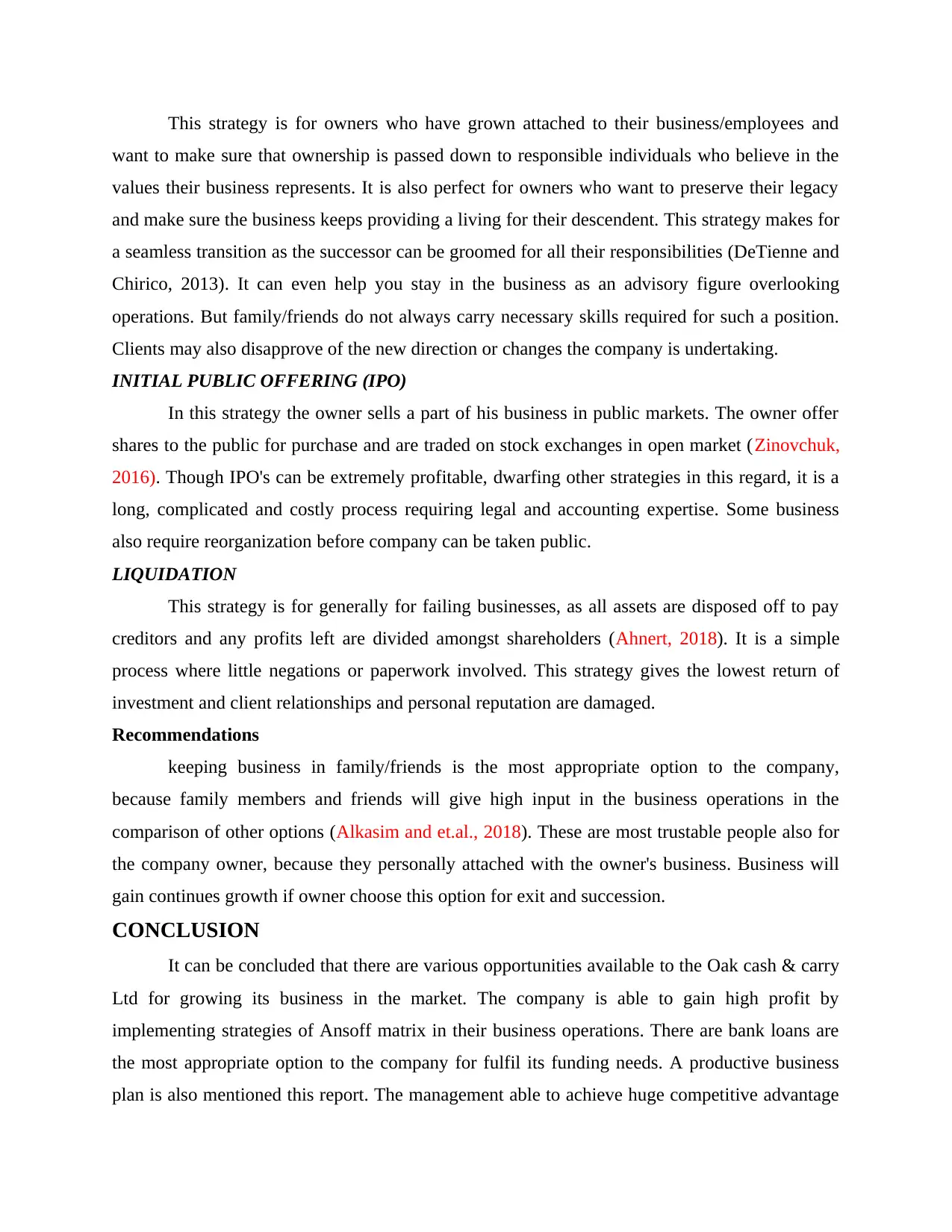
This strategy is for owners who have grown attached to their business/employees and
want to make sure that ownership is passed down to responsible individuals who believe in the
values their business represents. It is also perfect for owners who want to preserve their legacy
and make sure the business keeps providing a living for their descendent. This strategy makes for
a seamless transition as the successor can be groomed for all their responsibilities (DeTienne and
Chirico, 2013). It can even help you stay in the business as an advisory figure overlooking
operations. But family/friends do not always carry necessary skills required for such a position.
Clients may also disapprove of the new direction or changes the company is undertaking.
INITIAL PUBLIC OFFERING (IPO)
In this strategy the owner sells a part of his business in public markets. The owner offer
shares to the public for purchase and are traded on stock exchanges in open market (Zinovchuk,
2016). Though IPO's can be extremely profitable, dwarfing other strategies in this regard, it is a
long, complicated and costly process requiring legal and accounting expertise. Some business
also require reorganization before company can be taken public.
LIQUIDATION
This strategy is for generally for failing businesses, as all assets are disposed off to pay
creditors and any profits left are divided amongst shareholders (Ahnert, 2018). It is a simple
process where little negations or paperwork involved. This strategy gives the lowest return of
investment and client relationships and personal reputation are damaged.
Recommendations
keeping business in family/friends is the most appropriate option to the company,
because family members and friends will give high input in the business operations in the
comparison of other options (Alkasim and et.al., 2018). These are most trustable people also for
the company owner, because they personally attached with the owner's business. Business will
gain continues growth if owner choose this option for exit and succession.
CONCLUSION
It can be concluded that there are various opportunities available to the Oak cash & carry
Ltd for growing its business in the market. The company is able to gain high profit by
implementing strategies of Ansoff matrix in their business operations. There are bank loans are
the most appropriate option to the company for fulfil its funding needs. A productive business
plan is also mentioned this report. The management able to achieve huge competitive advantage
want to make sure that ownership is passed down to responsible individuals who believe in the
values their business represents. It is also perfect for owners who want to preserve their legacy
and make sure the business keeps providing a living for their descendent. This strategy makes for
a seamless transition as the successor can be groomed for all their responsibilities (DeTienne and
Chirico, 2013). It can even help you stay in the business as an advisory figure overlooking
operations. But family/friends do not always carry necessary skills required for such a position.
Clients may also disapprove of the new direction or changes the company is undertaking.
INITIAL PUBLIC OFFERING (IPO)
In this strategy the owner sells a part of his business in public markets. The owner offer
shares to the public for purchase and are traded on stock exchanges in open market (Zinovchuk,
2016). Though IPO's can be extremely profitable, dwarfing other strategies in this regard, it is a
long, complicated and costly process requiring legal and accounting expertise. Some business
also require reorganization before company can be taken public.
LIQUIDATION
This strategy is for generally for failing businesses, as all assets are disposed off to pay
creditors and any profits left are divided amongst shareholders (Ahnert, 2018). It is a simple
process where little negations or paperwork involved. This strategy gives the lowest return of
investment and client relationships and personal reputation are damaged.
Recommendations
keeping business in family/friends is the most appropriate option to the company,
because family members and friends will give high input in the business operations in the
comparison of other options (Alkasim and et.al., 2018). These are most trustable people also for
the company owner, because they personally attached with the owner's business. Business will
gain continues growth if owner choose this option for exit and succession.
CONCLUSION
It can be concluded that there are various opportunities available to the Oak cash & carry
Ltd for growing its business in the market. The company is able to gain high profit by
implementing strategies of Ansoff matrix in their business operations. There are bank loans are
the most appropriate option to the company for fulfil its funding needs. A productive business
plan is also mentioned this report. The management able to achieve huge competitive advantage
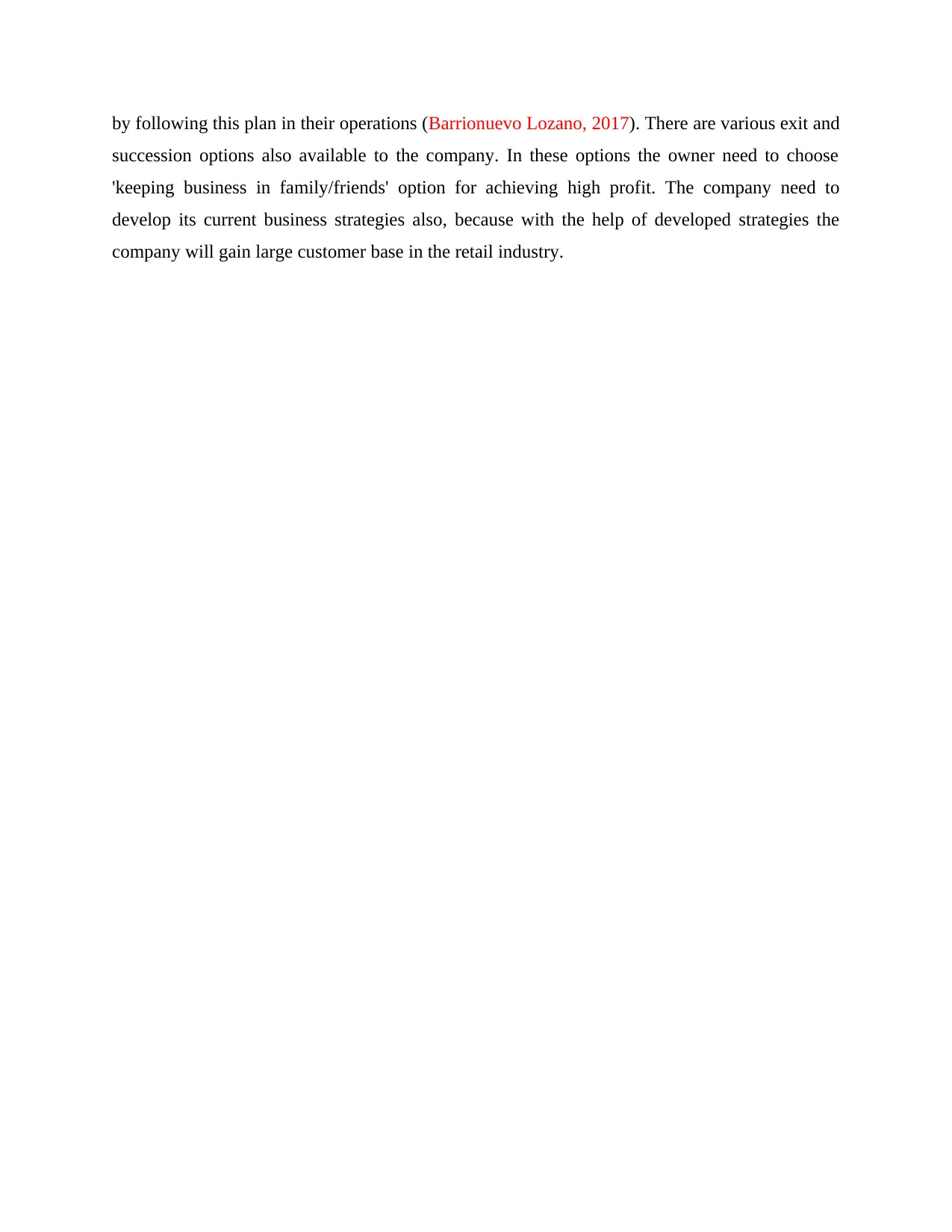
by following this plan in their operations (Barrionuevo Lozano, 2017). There are various exit and
succession options also available to the company. In these options the owner need to choose
'keeping business in family/friends' option for achieving high profit. The company need to
develop its current business strategies also, because with the help of developed strategies the
company will gain large customer base in the retail industry.
succession options also available to the company. In these options the owner need to choose
'keeping business in family/friends' option for achieving high profit. The company need to
develop its current business strategies also, because with the help of developed strategies the
company will gain large customer base in the retail industry.
Secure Best Marks with AI Grader
Need help grading? Try our AI Grader for instant feedback on your assignments.

REFERENCES
Books and Journals
Ahnert, T., 2018. Covered bonds as a Source of Funding for banks’ mortgage
portfolios. Financial System, p.37.
Alkasim, S. B and et.al., 2018. The mediating effect of cost leadership on the relationship
between market penetration, market development, and firm performance. Journal of
Business and Retail Management Research. 12(3).
Alon, I., and et.al., 2016. Global marketing: Contemporary theory, practice, and cases.
Routledge.
Amelung, V., Himmler, S. and Stein, V., 2017. Strategic Management and Integrated Care in a
Competitive Environment. In Handbook Integrated Care.(pp. 133-147). Springer,
Cham.]
Barrionuevo Lozano, M., 2017. Estudio de la estrategia empresarial de Pepsico Inc. a través de
los Portfolio Models y la matriz Ansoff.
Bates, L.K., 2018. Growth Without Displacement: A Test for Equity Planning in Portland.
Chiu, C.C. and Lin, K.S., 2019, July. Rule-Based BCG Matrix for Product Portfolio Analysis.
In International Conference on Software Engineering, Artificial Intelligence,
Networking and Parallel/Distributed Computing (pp. 17-32). Springer, Cham.
Council, C. C., 2018. Annual Business Plan and Budget.
Dawes, J., 2018. The Ansoff Matrix: A Legendary Tool, But with Two Logical Problems. But
with Two Logical Problems (February 27, 2018).
DeTienne, D.R. and Chirico, F., 2013. Exit strategies in family firms: How socioemotional
wealth drives the threshold of performance. Entrepreneurship Theory and Practice.
37(6). pp.1297-1318.
DeTienne, D.R., McKelvie, A. and Chandler, G.N., 2015. Making sense of entrepreneurial exit
strategies: A typology and test. Journal of Business Venturing. 30(2). pp.255-272.
Du, Q. and Yu, X., 2017, November. Research on Diversification Optimization of Investment
Business of A State-owned Company in Corps-Based on BCG Matrix. In 2nd
International Conference on Education Technology and Economic Management
(ICETEM 2017). Atlantis Press.
Filippov, D.V., 2017. Positioning of the Organization in the Target Markets Using the Modified
Three Dimensional Matrix Model on the Example of Transport Education Market of the
Republic of Sakha (Yakutia) of the Russian Federation. Advanced Science
Letters. 23(10). pp.9861-9865.
Grooms, W. and Frimpong Boamah, E., 2018. Toward a political urban planning: Learning from
growth machine and advocacy planning to “plannitize” urban politics. Planning
Theory. 17(2). pp.213-233.
Harding, S., 2017. MBA management models. Routledge.
Higgins, K. and Shepherd, J., IGT Inc, 2019. System and method for tracking funds from a
plurality of funding sources. U.S. Patent 10,380,843.
Huffman, E. and Stefanidis, D., 2019. Research Funding. In Success in Academic Surgery:
Developing a Career in Surgical Education. (pp. 159-171). Springer, Cham.
Kempenaar, A and et.al., 2016. Change of thought: Findings on planning for shrinkage from a
regional design competition. Planning Practice & Research. 31(1). pp.23-40.
Books and Journals
Ahnert, T., 2018. Covered bonds as a Source of Funding for banks’ mortgage
portfolios. Financial System, p.37.
Alkasim, S. B and et.al., 2018. The mediating effect of cost leadership on the relationship
between market penetration, market development, and firm performance. Journal of
Business and Retail Management Research. 12(3).
Alon, I., and et.al., 2016. Global marketing: Contemporary theory, practice, and cases.
Routledge.
Amelung, V., Himmler, S. and Stein, V., 2017. Strategic Management and Integrated Care in a
Competitive Environment. In Handbook Integrated Care.(pp. 133-147). Springer,
Cham.]
Barrionuevo Lozano, M., 2017. Estudio de la estrategia empresarial de Pepsico Inc. a través de
los Portfolio Models y la matriz Ansoff.
Bates, L.K., 2018. Growth Without Displacement: A Test for Equity Planning in Portland.
Chiu, C.C. and Lin, K.S., 2019, July. Rule-Based BCG Matrix for Product Portfolio Analysis.
In International Conference on Software Engineering, Artificial Intelligence,
Networking and Parallel/Distributed Computing (pp. 17-32). Springer, Cham.
Council, C. C., 2018. Annual Business Plan and Budget.
Dawes, J., 2018. The Ansoff Matrix: A Legendary Tool, But with Two Logical Problems. But
with Two Logical Problems (February 27, 2018).
DeTienne, D.R. and Chirico, F., 2013. Exit strategies in family firms: How socioemotional
wealth drives the threshold of performance. Entrepreneurship Theory and Practice.
37(6). pp.1297-1318.
DeTienne, D.R., McKelvie, A. and Chandler, G.N., 2015. Making sense of entrepreneurial exit
strategies: A typology and test. Journal of Business Venturing. 30(2). pp.255-272.
Du, Q. and Yu, X., 2017, November. Research on Diversification Optimization of Investment
Business of A State-owned Company in Corps-Based on BCG Matrix. In 2nd
International Conference on Education Technology and Economic Management
(ICETEM 2017). Atlantis Press.
Filippov, D.V., 2017. Positioning of the Organization in the Target Markets Using the Modified
Three Dimensional Matrix Model on the Example of Transport Education Market of the
Republic of Sakha (Yakutia) of the Russian Federation. Advanced Science
Letters. 23(10). pp.9861-9865.
Grooms, W. and Frimpong Boamah, E., 2018. Toward a political urban planning: Learning from
growth machine and advocacy planning to “plannitize” urban politics. Planning
Theory. 17(2). pp.213-233.
Harding, S., 2017. MBA management models. Routledge.
Higgins, K. and Shepherd, J., IGT Inc, 2019. System and method for tracking funds from a
plurality of funding sources. U.S. Patent 10,380,843.
Huffman, E. and Stefanidis, D., 2019. Research Funding. In Success in Academic Surgery:
Developing a Career in Surgical Education. (pp. 159-171). Springer, Cham.
Kempenaar, A and et.al., 2016. Change of thought: Findings on planning for shrinkage from a
regional design competition. Planning Practice & Research. 31(1). pp.23-40.
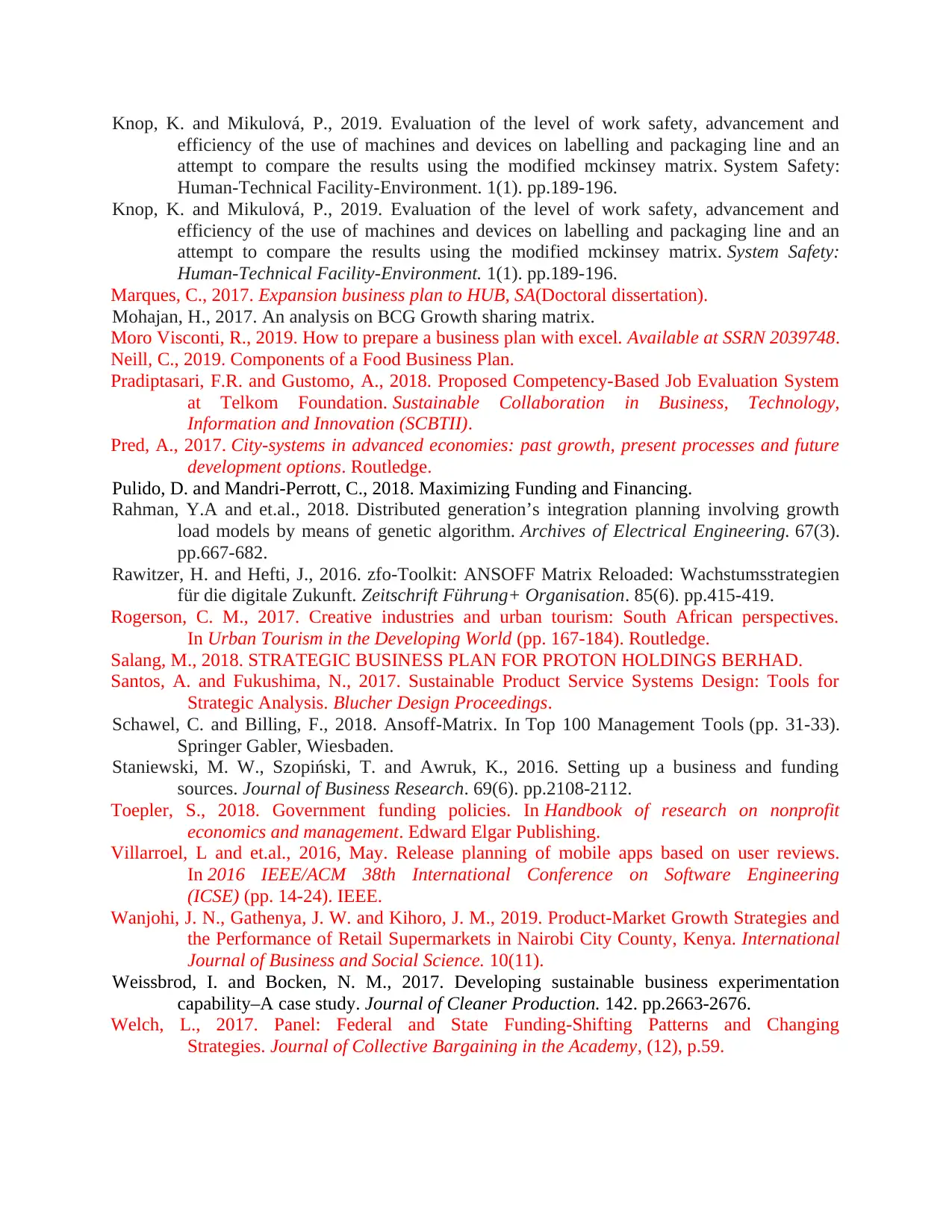
Knop, K. and Mikulová, P., 2019. Evaluation of the level of work safety, advancement and
efficiency of the use of machines and devices on labelling and packaging line and an
attempt to compare the results using the modified mckinsey matrix. System Safety:
Human-Technical Facility-Environment. 1(1). pp.189-196.
Knop, K. and Mikulová, P., 2019. Evaluation of the level of work safety, advancement and
efficiency of the use of machines and devices on labelling and packaging line and an
attempt to compare the results using the modified mckinsey matrix. System Safety:
Human-Technical Facility-Environment. 1(1). pp.189-196.
Marques, C., 2017. Expansion business plan to HUB, SA(Doctoral dissertation).
Mohajan, H., 2017. An analysis on BCG Growth sharing matrix.
Moro Visconti, R., 2019. How to prepare a business plan with excel. Available at SSRN 2039748.
Neill, C., 2019. Components of a Food Business Plan.
Pradiptasari, F.R. and Gustomo, A., 2018. Proposed Competency-Based Job Evaluation System
at Telkom Foundation. Sustainable Collaboration in Business, Technology,
Information and Innovation (SCBTII).
Pred, A., 2017. City-systems in advanced economies: past growth, present processes and future
development options. Routledge.
Pulido, D. and Mandri-Perrott, C., 2018. Maximizing Funding and Financing.
Rahman, Y.A and et.al., 2018. Distributed generation’s integration planning involving growth
load models by means of genetic algorithm. Archives of Electrical Engineering. 67(3).
pp.667-682.
Rawitzer, H. and Hefti, J., 2016. zfo-Toolkit: ANSOFF Matrix Reloaded: Wachstumsstrategien
für die digitale Zukunft. Zeitschrift Führung+ Organisation. 85(6). pp.415-419.
Rogerson, C. M., 2017. Creative industries and urban tourism: South African perspectives.
In Urban Tourism in the Developing World (pp. 167-184). Routledge.
Salang, M., 2018. STRATEGIC BUSINESS PLAN FOR PROTON HOLDINGS BERHAD.
Santos, A. and Fukushima, N., 2017. Sustainable Product Service Systems Design: Tools for
Strategic Analysis. Blucher Design Proceedings.
Schawel, C. and Billing, F., 2018. Ansoff-Matrix. In Top 100 Management Tools (pp. 31-33).
Springer Gabler, Wiesbaden.
Staniewski, M. W., Szopiński, T. and Awruk, K., 2016. Setting up a business and funding
sources. Journal of Business Research. 69(6). pp.2108-2112.
Toepler, S., 2018. Government funding policies. In Handbook of research on nonprofit
economics and management. Edward Elgar Publishing.
Villarroel, L and et.al., 2016, May. Release planning of mobile apps based on user reviews.
In 2016 IEEE/ACM 38th International Conference on Software Engineering
(ICSE) (pp. 14-24). IEEE.
Wanjohi, J. N., Gathenya, J. W. and Kihoro, J. M., 2019. Product-Market Growth Strategies and
the Performance of Retail Supermarkets in Nairobi City County, Kenya. International
Journal of Business and Social Science. 10(11).
Weissbrod, I. and Bocken, N. M., 2017. Developing sustainable business experimentation
capability–A case study. Journal of Cleaner Production. 142. pp.2663-2676.
Welch, L., 2017. Panel: Federal and State Funding-Shifting Patterns and Changing
Strategies. Journal of Collective Bargaining in the Academy, (12), p.59.
efficiency of the use of machines and devices on labelling and packaging line and an
attempt to compare the results using the modified mckinsey matrix. System Safety:
Human-Technical Facility-Environment. 1(1). pp.189-196.
Knop, K. and Mikulová, P., 2019. Evaluation of the level of work safety, advancement and
efficiency of the use of machines and devices on labelling and packaging line and an
attempt to compare the results using the modified mckinsey matrix. System Safety:
Human-Technical Facility-Environment. 1(1). pp.189-196.
Marques, C., 2017. Expansion business plan to HUB, SA(Doctoral dissertation).
Mohajan, H., 2017. An analysis on BCG Growth sharing matrix.
Moro Visconti, R., 2019. How to prepare a business plan with excel. Available at SSRN 2039748.
Neill, C., 2019. Components of a Food Business Plan.
Pradiptasari, F.R. and Gustomo, A., 2018. Proposed Competency-Based Job Evaluation System
at Telkom Foundation. Sustainable Collaboration in Business, Technology,
Information and Innovation (SCBTII).
Pred, A., 2017. City-systems in advanced economies: past growth, present processes and future
development options. Routledge.
Pulido, D. and Mandri-Perrott, C., 2018. Maximizing Funding and Financing.
Rahman, Y.A and et.al., 2018. Distributed generation’s integration planning involving growth
load models by means of genetic algorithm. Archives of Electrical Engineering. 67(3).
pp.667-682.
Rawitzer, H. and Hefti, J., 2016. zfo-Toolkit: ANSOFF Matrix Reloaded: Wachstumsstrategien
für die digitale Zukunft. Zeitschrift Führung+ Organisation. 85(6). pp.415-419.
Rogerson, C. M., 2017. Creative industries and urban tourism: South African perspectives.
In Urban Tourism in the Developing World (pp. 167-184). Routledge.
Salang, M., 2018. STRATEGIC BUSINESS PLAN FOR PROTON HOLDINGS BERHAD.
Santos, A. and Fukushima, N., 2017. Sustainable Product Service Systems Design: Tools for
Strategic Analysis. Blucher Design Proceedings.
Schawel, C. and Billing, F., 2018. Ansoff-Matrix. In Top 100 Management Tools (pp. 31-33).
Springer Gabler, Wiesbaden.
Staniewski, M. W., Szopiński, T. and Awruk, K., 2016. Setting up a business and funding
sources. Journal of Business Research. 69(6). pp.2108-2112.
Toepler, S., 2018. Government funding policies. In Handbook of research on nonprofit
economics and management. Edward Elgar Publishing.
Villarroel, L and et.al., 2016, May. Release planning of mobile apps based on user reviews.
In 2016 IEEE/ACM 38th International Conference on Software Engineering
(ICSE) (pp. 14-24). IEEE.
Wanjohi, J. N., Gathenya, J. W. and Kihoro, J. M., 2019. Product-Market Growth Strategies and
the Performance of Retail Supermarkets in Nairobi City County, Kenya. International
Journal of Business and Social Science. 10(11).
Weissbrod, I. and Bocken, N. M., 2017. Developing sustainable business experimentation
capability–A case study. Journal of Cleaner Production. 142. pp.2663-2676.
Welch, L., 2017. Panel: Federal and State Funding-Shifting Patterns and Changing
Strategies. Journal of Collective Bargaining in the Academy, (12), p.59.
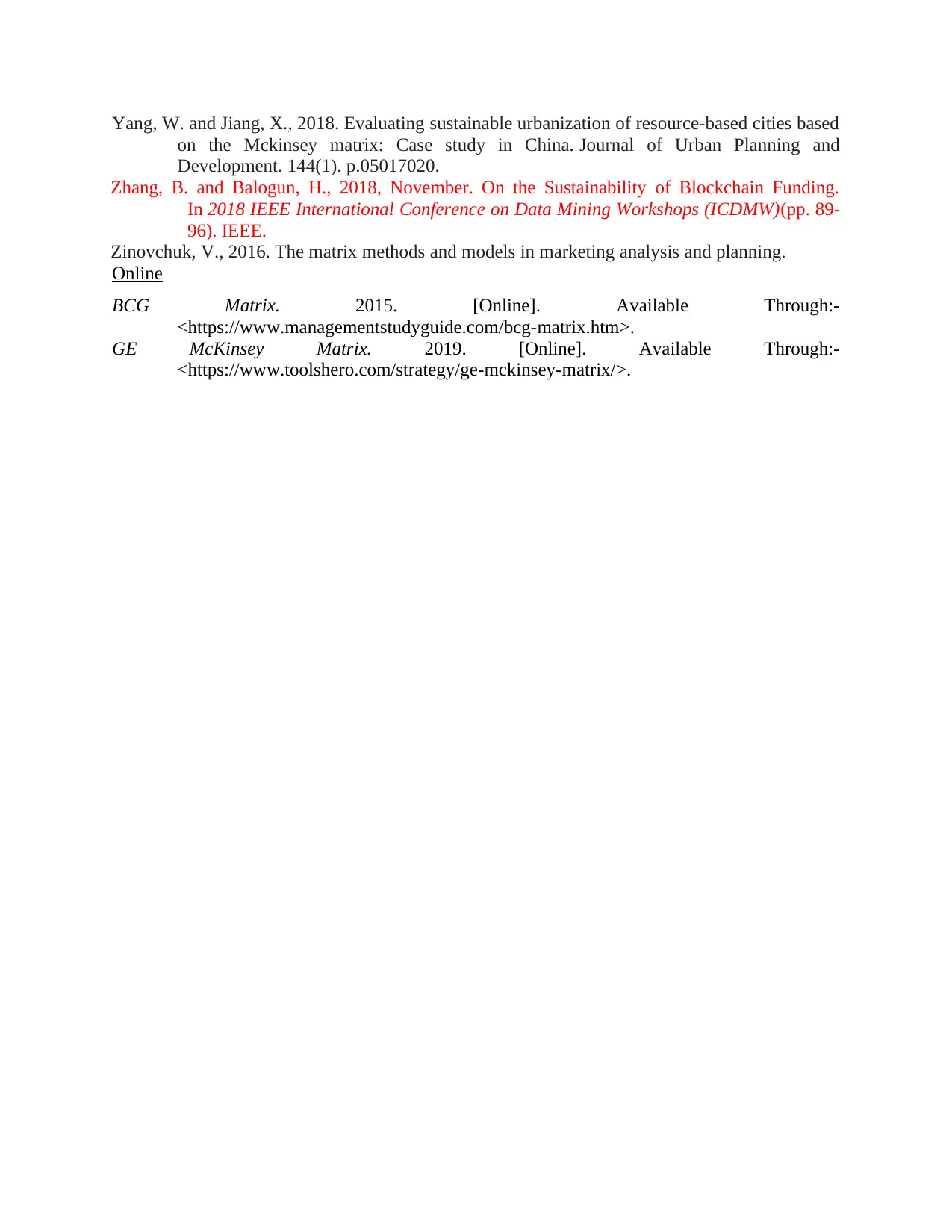
Yang, W. and Jiang, X., 2018. Evaluating sustainable urbanization of resource-based cities based
on the Mckinsey matrix: Case study in China. Journal of Urban Planning and
Development. 144(1). p.05017020.
Zhang, B. and Balogun, H., 2018, November. On the Sustainability of Blockchain Funding.
In 2018 IEEE International Conference on Data Mining Workshops (ICDMW)(pp. 89-
96). IEEE.
Zinovchuk, V., 2016. The matrix methods and models in marketing analysis and planning.
Online
BCG Matrix. 2015. [Online]. Available Through:-
<https://www.managementstudyguide.com/bcg-matrix.htm>.
GE McKinsey Matrix. 2019. [Online]. Available Through:-
<https://www.toolshero.com/strategy/ge-mckinsey-matrix/>.
on the Mckinsey matrix: Case study in China. Journal of Urban Planning and
Development. 144(1). p.05017020.
Zhang, B. and Balogun, H., 2018, November. On the Sustainability of Blockchain Funding.
In 2018 IEEE International Conference on Data Mining Workshops (ICDMW)(pp. 89-
96). IEEE.
Zinovchuk, V., 2016. The matrix methods and models in marketing analysis and planning.
Online
BCG Matrix. 2015. [Online]. Available Through:-
<https://www.managementstudyguide.com/bcg-matrix.htm>.
GE McKinsey Matrix. 2019. [Online]. Available Through:-
<https://www.toolshero.com/strategy/ge-mckinsey-matrix/>.
1 out of 19
Related Documents
Your All-in-One AI-Powered Toolkit for Academic Success.
+13062052269
info@desklib.com
Available 24*7 on WhatsApp / Email
![[object Object]](/_next/static/media/star-bottom.7253800d.svg)
Unlock your academic potential
© 2024 | Zucol Services PVT LTD | All rights reserved.





